Fleetwood - The Mini Quest
by Lachlan Davidson, 2010
In about 1979 my wonderful mother agreed to buy my sister and I a Mini Quest catamaran. They are fourteen feet long, designed (by Charlie and Lyndsay Cunningham) to be built at home and to be raced by a single person. They have a trapeze and very fast and exciting, just the thing for a seventeen year old boy with five years sailing experience, a competitive spirit and a thirst for excitement. My sister didn’t get so much use out of the boat as she was leaving home and moving on.
One of the few factory-built Mini Quests, she is a fast, fairly light boat with a good sail (Black Sails company) ut came without a trailer or a name to speak of so we borrowed trailers and lifts until I converted our rusty old box-trailer and I named her “Fleetwood” because she is fast and made of wood, not because of Fleetwood Mac.
I love to race and my light weight and youthful belief led me to win some early races in light weather. The Easter regatta at Waranga was the first time I had raced Fleetwood and Michael Clarkson kindly offered to put her on the top of his boat “Virago” (also using Black sails) and I came home with the trophy ahead of about 5 other Minis. I knew I had a good boat.
Heavy winds found me out and always tested my courage and weight but I always preferred the tactical racing in light to medium conditions rather than the on-the-edge survival conditions over 15 knots. My courage showed in brave tactics rather than risking capsize or damage, though I did both at times.
My first state title series at Lake Wellington (1980?) saw me in front with one race to go (light conditions) and leading the last race with one leg to go when a wall of trailer sailors appeared between me and the finish line. I made a choice which cost me the race and the series and put a (necessary) dent in my ego. Second place it was behind a worthy Brian Samson and I didn’t win a State title until about six years later when there was a handful of boats and the class had all but died out. A somewhat hollow victory but I remain reigning Mini Quest Champion and, as there were never any National titles I jokingly called myself world champion as a talking point. A little pretentious as it was pointed out to me so back to just past champion for honesty’s sake.
Having sailed at Carrum for nearly ten seasons on my wonderful boat and having gone to regattas at clubs around the bay including One-of-a-kinds and multi-hull races I’d beaten large numbers of Paper Tigers, particularly in light winds and had a fantastic Champion of Champions race at the Sauna sail in Morwell once where every wind shift went my way only to be beaten on handicap by an Arafura coming home with a front), I’d had a fantastic time. It was time, however regrettably to move on. There were no Mini Quests to race against. I had no-where to keep her at our new home and Ken Lott, an exceptional Mosquito sailor had asked me to crew for him.
Very reluctantly we sold Fleetwood to a neighbour who then sold her again a few months later. Not what he was really looking for.
In the years to follow Ken and I made a great team though never were able to put it together for a State or National title, not through lack of ability or a bad boat. He made awesome boats. Eventually music and marriage stopped my sailing career and all I did was dream about it, always Fleetwood and often waking up literally in tears. I remember once seeing her come off the trailer and going over a cliff to smash up on rocks at the bottom. That was one of the worst dreams I ever had and I still recall the immense feeling of loss when I woke up from that one.
2003 Enter Fred. Fred (Fiona R.) had been a student at PLC and had become (along with her family) a really good and supportive friend after school had finished for her, particularly through my divorce.
We had kept in regular touch since then until a phone call at school from her asking me to play at her wedding. It went like this. My mobile phone rang and it was Fred. We had a brief chat until the phone went flat. Shortly after that the music secretary’s phone rang and I knew it would be Fred so I went to her phone and announced, “Hello Lachlan Davidson, World Mini Quest champion” (to be funny) and Fred said “Of course. Hey, Scott, my fiancee has a Mini Quest in his parents garage.” My interest was raised. As there were not many boats ever built I thought I might know this boat. “Wow. Do you know what number it is?” I said. Fred asked Scott and he thought 82 maybe. My heart skips a beat. Fleetwood is 81. “What colour is it?” “White” Fred replies. Fleetwood is white. Heart skipping many beats. Jane is staring at me. I ask the all-important question… What is its name?
Fleetwood!
I am actually in tears as I type this.
Well Jane erupts into copious “Oh my God,” I can hardly speak, and Scott and I (who have never met) begin talking about a shared passion. We were kind of like long lost brothers.
He had bought the boat from my neighbour though he was on his way to buy a windsurfer I believe.
He hadn’t raced her but had sailed fairly often at Balnarring until five years before (He’d had Fleetwood for nearly fifteen years) when she’d been put in his parents garage and the old trailer thrown away. He’d thought of selling her but hadn’t got around to it and, hearing my passion for her offered to give her to me. What a gesture! I sort of accepted in that I bought a trailer, adapted it to take Fleetwood, picked her up from his parents garage took her home, washed her off, bought a new mainsheet and some fittings but agreed that we would share her and that I would make her available anytime he wanted to sail her.
We’ve sailed her together at least once a year since and I’ve taken her in a couple of races and sailed her a few other times. In fact e were barrelling along in a strong wind at Balnarring with Scott out on Trapeze (asking a lot of a Thirty year old cat) when two dolphins swan with us between the bows. What a moment of blessing that was! When the kids are older I think I might just have to find a club to race her at again and see what I can do to the egos of a few Paper Tiger sailors who think this old girl is past it. The youthful competitor lives and waits for his time to come again but for now he is very, very happy so see his old friend in the yard every day.
Did You Know That We Offer Contract to Closing Services? Click Here to Find Out More.
Need Marine Financing? Apply Here With Our Partner, First Approval Source
- Catamaran Interviews
- Catamaran Reviews
- Buying Advice
- Selling Advice
- Woods Design Advice
- Admiral 38
- Admiral 40
- Admiral 50
- Americat 3014
- Antares 44
- Aquila 44
- Aquila 48 Power Catamaran
- Aventura 37
- Balance 442
- Balance 482
- Balance 526
- Bali 4.0
- Bali 4.1
- Bali 4.2
- Bali 4.3
- Bali 4.4
- Bali 4.5
- Bali 4.6
- Bali 4.8
- Bali 40 Catspace
- Bali 5.4
- Bali Catsmart
- Beneteau Blue II
- Broadblue 346
- Broadblue 38 Prestige
- Broadblue 385
- Broadblue 435
- Broadblue 46
- Rapier 400
- Rapier 550
- Catalac 10M
- Catalac 11M
- Catalac 12M
- Catalac 8M
- Catalac 900
- Catalac 9M
- Catana 381
- Catana 39
- Catana 401
- Catana 40S
- Catana 411
- Catana 42
- Catana 42 S
- Catana 431
- Catana 44
- Catana 471
- Catana 50
- Catana 521
- Catana 531
- Catana 55
- Catana 581
- Catana 65
- Catathai 44
- Chris White
- Chris White 48 Voyager
- Chris White 55
- Condor 40
- Contour 34
- Corsair F28 R
- De Villiers
- Dean 365
- Dean 400
- Dean 440
- Dean 500
- Dix DH550
- Dolphin 380
- Dolphin 460
- Edel 35
- Endeavour 30
- Endeavour 35 Victory
- Endeavour 36
- Endeavour 44
- Endeavour 44 TrawlerCat
- Endeavour 50 Pilothouse Trawler
- Excess 11
- Excess 15
- F-41
- Fastback 43
- Fastcat 445
- Fisher 28
- Fisher 32
- Fortuna 36 Island Spirit
- Fortuna 401 Island Spirit
- Fountaine Pajot
- FP 32 Maldives
- FP 35 Tobago
- FP 36 Mahe
- FP 37 Antigua
- FP 38 Athena
- FP 39 Fidji
- FP 40 Isla
- FP 40 Lavezzi
- FP 40 Lucia
- FP 40 MY
- FP 40 Summerland MY
- FP 41 Lipari
- FP 42 Astrea
- FP 42 Venezia
- FP 43 Belize
- FP 44 Helia
- FP 44 Orana
- FP 45 Elba
- FP 46 Bahia
- FP 46 Casamance
- FP 48 Salina
- FP 50 Saba
- FP 56 Marquises
- FP 57 Sanya
- FP 58 Ipanema
- FP 60 Eleuthera
- FP Saona 47
- Fusion 40
- Gemini 105
- Gemini 3000
- Gemini 3200
- Gemini 3400
- Gemini Freestyle 37
- Gemini Freestyle 399 Power
- Gemini Legacy 35
- Grainger 420 Mystery Cove
- Gunboat 55
- Hirondelle 7M
- HopYacht 30
- Island Packet
- Island Packet Cat 35
- Kennex 420
- Knysna 440
- Knysna 480
- Knysna 500
- Knysna 550
- Lagoon 35
- Lagoon 37 TPI
- Lagoon 380
- Lagoon 39
- Lagoon 40
- Lagoon 400
- Lagoon 410
- Lagoon 42
- Lagoon 42 TPI
- Lagoon 420
- Lagoon 421
- Lagoon 43 PC
- Lagoon 44 Power Cat
- Lagoon 440
- Lagoon 450
- Lagoon 46
- Lagoon 470
- Lagoon 50
- Lagoon 500
- Lagoon 52F
- Lagoon 55
- Lagoon 560
- Lagoon 570
- Lagoon 620
- Lagoon Seventy 8
- Lagoon Sixty 7
- Leeuwin 42
- Leopard 38
- Leopard 39
- Leopard 39 PowerCat
- Leopard 40
- Leopard 42
- Leopard 43
- Leopard 44
- Leopard 45
- Leopard 45 Classic
- Leopard 46
- Leopard 46 Lion PowerCat
- Leopard 47
- Leopard 47 PowerCat
- Leopard 48
- Leopard 50
- Leopard 51 PowerCat
- Leopard 53 PowerCat
- Leopard 58
- Lidgard 73 Executive
- Looping 50
- Maine Cat 30
- Maine Cat 38
- Maine Cat 41
- Manta 40
- Manta 42
- Matrix 450 Vision
- Matrix 760 Silhouette
- Maverick 400
- Maverick 420
- Maverick 440
- Moxie 61
- Nautitech 40
- Nautitech 40 Open
- Nautitech 44 Open
- Nautitech 442
- Nautitech 46 Open
- Nautitech 47
- Nautitech 47 Power
- Nautitech 475
- Nautitech 65
- Neel 45
- Neel 47
- Outremer 40
- Outremer 45
- Outremer 50 Standard
- Outremer 55
- Outremer 5X
- PDQ 32
- PDQ 36
- PDQ 42 Antares
- Privilege 37
- Privilege 39
- Privilege 42
- Privilege 43
- Privilege 435
- Privilege 45
- Privilege 465
- Privilege 48 Transcat
- Privilege 482
- Privilege 495
- Privilege 510
- Privilege 65
- Privilege Serie 5
- Prout 31 Quest
- Prout 33 Quest
- Prout 34 Event
- Prout 35 Snowgoose
- Prout 37 Snowgoose
- Prout 37 Snowgoose Elite
- Prout 38
- Prout 38 Manta
- Prout 39 Escale
- Prout 45
- Prout 46
- Royal Cape 45
- Royal Cape 500 Majestic
- Royal Cape 530 Majestic
- Sailcraft 30 Iroquois
- Sailcraft 32 Comanche
- Sailcraft 35 Cherokee
- Sailcraft 41 Apache
- Sailcraft 44 Apache
- Scape 39
- Wildcat 350
- Seacart 30
- Seawind 1000
- Seawind 1160
- Seawind 1190
- Seawind 1200
- Seawind 1260
- Seawind 1600
- Simpson 48
- Solaris 36 Sunrise
- Solaris 36 Sunstar
- Solaris 42
- St Francis 44
- St Francis 48
- St Francis 50
- Stealth 11.8
- Sunreef 60
- Sunreef 62
- Sunreef 70
- Sunreef 74C
- Sunreef 82 DD
- Sunreef 88 DD
- Switch 51
- Switch 55
- TRT 1200
- Heavenly Twins 26
- Ocean Twins 38
- Vaan R5
- Vision 444
- Voyage 380 Maxim
- Voyage 400 Norseman
- Voyage 430 Norseman
- Voyage 440
- Voyage 450 Cabriolet
- Voyage 47 Mayotte
- Voyage 480
- Voyage 500
- Voyage 580
- Voyage 590
- Kronos 45
- Wharram 38 Tiki
- AMI 320 Renaissance
- Woods 22 Wizard
- Woods 35 Banshee
- Woods 35 Flica
- Woods 36 Scylla
- Woods 36 Vardo
- Woods 38 Transit
- Woods 40 Meander
- Xquisite X5
- Xquisite X5+

10 Best Pocket Catamarans (Under 38 ft)
- Post author By Rick
- Post date September 11, 2020
- 3 Comments on 10 Best Pocket Catamarans (Under 38 ft)

Smaller cruising catamarans are an excellent entry level gateway into cruising catamarans and of late have become very popular. This is an effort to select some of the most well respected of these smaller catamarans. This was a difficult task, as many of these boats, designed and built some time ago, are still found in all the popular cruising grounds, and a list like this is subjective after all. All I can do is apologize in advance for leaving a boat off this list.
- Prout Snowgoose 37

The Snowgoose (all iterations) was the first truly popular mass produced catamaran with more than 500 built. Known as safe, strong and capable of being sailed off shore, which some say is because of the position of their main mast, they make a perfect coastal cruiser or circumnavigator for an adventurous couple. This is a lot of boat for the money. These boats began their model run as a 35’ boat but as time went on Prout changed the mould by extending them to 37’. The Snowgoose can be found in every ocean on the planet.
The interior is simple and lightweight in order to maintain good sailing performance. A combination of classic woods and modern materials give the boat a spacious and open feeling that is hard to find on a boat this size.
Under sail, the Prout Snowgoose 37 is consistent, and it doesn’t need to be micromanaged, making it an ideal passagemaker. During passages,150 miles per day can be expected without pushing the boat. The Snowgoose 37, with its flexible cutter rig, balances easily and handles well under autopilot.
The Snowgoose is renowned for its rugged construction and sea kindliness as these boats were built to cross oceans, and not as additions to Caribbean charter fleets. Somewhere around 500 boats were built, and, although statements like this are impossible to confirm, its been said that nearly 100 have completed circumnavigations. True or not, Prouts have probably done more circumnavigations than any other catamaran of their era. The Prout designs have proven themselves time and again as tough, reliable cruisers and if a sailor wants a cat to sail around the world, there’s a good chance he’ll probably end up in a Snowgoose.
- Gemini 105M

The most popular American line of catamarans with over 1100 deliveries, this Gemini 105MC is one of the most affordable catamarans on the market. The Gemini’s performance is legendary yet they still manage to surprise unsuspecting newcomers.
These boats squeeze 3 cabins, a head and full Galley (in starboard hull) and a deck layout and rig which offers a stable, safe, and well-reasoned platform for whatever comes your way. And the ingenuity of lifting centerboards and kick-up rudders will have you sailing through less than 2′ of water, making this boat the ultimate Island hopper. All this and more at 33′ 6″ length and a 14′ beam that can dock in a standard slip or truck across the country.
The Gemini 105M has plenty of room, is an excellent value, with outstanding accommodations, and solid sailing performance.
- The Lagoon 37 TPI

The Lagoon 37 TPI catamaran was built by the famed boat yard Tillotson Pearson in Rhode Island. They were introduced in 1993 following the success of the Lagoon 42 in the US charter market and draws from a long lineage of great multihull designs and continues the collaboration of Jeanneau of France, and TPI (American). With the same designers and builders as the forerunner model and targeting the same market, these boats have achieved cult status among catamaran sailors. Their pointing ability, and comfort aboard are legendary. These boats were designed with the much preferred straight propeller shafts instead of sail drives and were sold as 3 cabin 2 head laid out as an Owner’s Version.
A French design, built in the USA by TPI in Rhode Island, they have become a very sought-after catamaran. These boats are fast and comfortable both at sea and at anchor with ample storage room and comfortable accommodations.

The PDQ 36 was a Canadian built catamaran offered in two arrangements. The LRC (Long Range Cruiser) is a legend among cruising catamarans and included 2 Yanmar diesel engines coupled to straight shafts. The PDQ 36 Capella, was built with pods for two Yamaha extended shaft outboards.
These are solid boats with excellent construction as the expert use of materials and construction techniques results in a strong boat yet keeps the hull weight low. With twin inboard diesels, she’s designed for coastal cruising. They aren’t seen for sale very often.
These are well-built and well-regarded catamarans, designed with a gracious entertaining area, and two luxurious staterooms complete with queen-size beds. At 36′ the boat is the ideal size for single-handing, as the twin engines contribute to excellent maneuverability in tight spaces while the diesel engine version offering considerable charging capability.
Two equal staterooms with plenty of storage throughout the boat. The head and shower stall are one piece for easy cleaning. The galley is located in the port hull, has dual sinks, a Force 10 oven with two burner range and refrigerator for easy access. The salon seats six for dining.
The cockpit is spacious with pilot and co-pilot seats and an aft bench seat. The engines are either inboard diesels or in pods and retract out of the water for no drag when under sail.

The Catalac 9M was a British built, 30 foot design, with a modest rig, high coach roof, large cockpit and 5 berths in four sleeping areas which provided lots of sun bathing deck space, a shallow draft, and had reasonable performance. In a good blow (>20 knots of wind speed) 10 knots at 45 degress apparent can be expected from the Catalac 9M and in enough wind the boat will tack inside of 45 degrees. In strong quarterly winds speeds of 12-14 knots under sail has been documented with the outboard engine configuration in a lightly loaded boat. Remarkable performance from such a boxy design given that it’s design priority was comfort rather than speed
The mast is cabin stepped in a tabernacle. These were designed be raised and lowered single handed. They were sold with a mainsail, working jib and a 170% Genoa. When the rig is set up correctly, they sail with a very balanced helm. Twin rudders contribute to their agility and later models (>1980) have matching skegs just forward of the rudders to increase windward ability. About 250 boats were built.
- Endeavour 36

EndeavourCat 36 cruising catamaran is an American designed and buit boat by Endeavour Catamaran Corporation of Clearwater, FL. The EndeavourCat 36 draws less than 3 feet and can go most places that others can’t. These boats are very easily docked with twin diesel engines. They were built with three staterooms with queen-size beds. There are identical staterooms aft in each hull with a bedside table, hanging locker and drawers. Each stateroom has a ceiling light, reading lights, large hatches, opening ports. The bright, airy salon can comfortably seat 6-8.
The Galley is located in the port hull and is large enough for two people to prepare a gourmet meal side by side. Designed to be sailed single-handed without ever leaving the cockpit, all lines lead to the cockpit, two two-speed winches make easy work of sail handling. Both main and jib are completely self-tacking.
- Endeavour 30

The Endeavour 30 was built by Endeavour Catamaran Corporation of Clearwater, FL and features spacious Salon, Massive Galley, Huge Head with separate two-person shower with a built-in seat. Twin Queen births with full hanging cedar lined closest and plentiful storage space. The hull, deck, and structural bulkheads are manufactured of biaxial fiberglass with isophathalic vinylester resins and NidaCore (a polypropelene honeycomb) coring. Vacuum bagged construction was used to enhance stiffness, strength, and reduce weight. There is a full interior fiberglass grid used as the interior mold for strength and rigidity. The headliner is a full fiberglass molded piece. The hulls and decks are fastened both chemically and mechanically for strength. Twin fiberglass molded keels are foam filled and have integral sumps. The balanced rudders are constructed of high denisty foam/fiberglass.
These boats have a very unique layout merging the cabin with the cockpit with broad companionway doors. Tons of features packed into her 30 foot length. A lot of catamaran for the money.
- Fountaine Pajot Mahe 36

Fountaine Pajot Mahe 36 was based on an Olivier Flahault design and with a Joubert/Nivelt hull, The Mahe 36 is built for safe navigation with comfortable, bright living areas and a fully protected cockpit alongside the salon.
The Mahe 36 features an open-plan / sheltered cockpit and saloon and raised helm station. Entering the main salon through the sliding cockpit door the well-appointed galley is to starboard and the Nav station and storage is to port. Down into the starboard hull is the master stateroom aft with a Queen berth with several opening ports, a hanging locker and shelf storage with vented doors.
Forward to starboard is the ample head with shower which is a single fiberglass unit very easy to keep clean. Down from the saloon to the port guest stateroom aft with a Queen berth with several opening ports , a hanging locker and shelf storage with vented doors. Forward to port is the ample head with shower which is a single fiberglass unit very easy to keep clean. The large windows forward, Port and Starboard in the saloon make for an airy, open feeling.
These boat offers great comfort both sailing and at anchor while at the same time offering excellent performance. The Mahé 36 allows you to move around freely onboard, enjoying comfort when navigating (at the helm, in the cockpit or down below) or while moored. Everything has been thought out so that you can move about on this 36 ft yacht without anything getting in the way.

The Catalac 8M is a pocket cruising catamaran which has a solid reputation for quality, strength and durability. Many of the boats found in North America today, were sailed there from Great Britain. The Catalac 8M, although classified as a pocket cruiser was designed with blue water sailing in mind. Offered in two versions, twin diesels or a single outboatd engine. The twin inboard diesel models can easily motor almost 1000 kilometers without refueling. The 70 amps of charging and 70 gallons of stock water tanks in the Catalac 8M and 9M make even these smaller boats terrific coastal cruisers. The Outboard versions sail a bit quicker as the engine can be raised during sailing, reducing drag. Constructed with solid fiberglass hulls, these are quality boats which were built like battleships. Chuck Kanter calls them one of the catamaran brands that live on through the decades.
The Catalac 8M is masthead rigged with a relatively short, but thick mast. As with all boats in the Catalac production lineup, this contributes to a stable boat with a low center of effort. No Catalac has ever been known to fly a hull under any circumstances.
The mast is cabin stepped in a tabernacle. These can be raised and lowered single handed. The standing rigging is over sized to withstand the extra loading experienced by catamarans. They were sold with a mainsail, working jib and a 170% Genoa. When the rig is set up correctly, they sail with a very balanced helm. Twin rudders contribute to their agility and later models (>1980) have matching skegs just forward of the rudders to improve windward ability.
Designed with a single full size berth forward, a large 8 foot long galley in the starboard hull, a quarter berth, nav station and head in the Port hull, these small catamarans pack a lot of features in a small package. Their cockpits are as large as a 38 – 40 foot catamaran. Most of these boats are in Europe but a fail number were either imported or sailed to North America.
- Seawind 1000

The Seawind 1000 is an Australian built 37′ catamaran. These Australian designed and built catamarans have won world wide acclaim and awards for their stability, spaciousness, luxury and performance. The Seawind 1000’s blend of simplicity and sophistication is an example of what a modest cruising catamaran needs to serve the minimum needs of its crew, and what it should have to make sailors want to use and keep their beloved catamaran.
She has a well equipped galley with plenty of bench space and storage and the large open saloon. Featuring 2 cabins, 4 berths, large bathroom, and very nice galley. They feature a large double bed, additonal bunk and bathroom portside. On the starboard side, kitchen, additional bunk, desk and seperate cabin. The saloon features a large table that can convert to a huge daybed for lounging while under sail. Her large trampolines up front are perfect to laze around and for sun baking. The large open saloon with seating and table is fully open to the cockpit for plenty of space for the guests to move around.
The functional galley is loaded with fridge, a small oven and gas 2 burner stove top making meal preparation hassle free. She has a galley bench top w/ integral double sink and drain.
The Seawind 1000 is a solid, safe cruising catamaran that moves beautifully in the water and more than comfortable to live on.
- Tags Buying Advice

Owner of a Catalac 8M and Catamaransite webmaster.
3 replies on “10 Best Pocket Catamarans (Under 38 ft)”
Thank you, Rick. My wife and I are planning on cruising the Med in a few years and the boats profiled give a good starting point for the “perfect” boat. ?
Excellent work…
Gerry Gray hear from Pointe Claire Yacht club looking to buy a super clean pocket cat on the east coast or in the carribean or central america….under 100k cad please.
Cheers Gerry
Hi Gerry: Best thing to do is sign up for our mailing list to be first to hear of new catamarans.
https://www.catamaransite.com/contact-enroll/
Leave a Reply Cancel reply
Your email address will not be published. Required fields are marked *
Save my name, email, and website in this browser for the next time I comment.
- Skip to main content
- Skip to primary sidebar
- Skip to footer
The Boat Galley
making boat life better

10 Small Catamarans for Cruisers
Published on January 23, 2021 ; last updated on November 7, 2023 by Carolyn Shearlock/Rick Marcarelli

I hear from many readers interested in small catamarans. Recently, the folks at www.CatamaranSite.com reached out to interview me about our experience cruising on our Gemini 105, Barefoot Gal and we began chatting about the various small catamarans on the market. One thing led to another and I’m pleased that Rick Marcarelli was willing to contribute a guest post sharing information comparing ten of the most popular small catamarans on the market.
When most buyers think of catamarans these days, they think of designs by Lagoon, Leopard, and Fountaine Pajot.
These are all fine vessels. But they were built to cater to the charter markets. And so they may not be the best boats for long-term, liveaboard cruisers.
Charter vs Liveaboard Cruising
The typical charter catamaran accommodates three or four couples sailing for one to two weeks in the Caribbean or Mediterranean. Usually they will provision once, sail a few daylight hours, eat out more than a typical cruiser, and anchor or moor for the night.
Compare that itinerary to the typical liveaboard cruiser.
Most cruisers spend over 90% of their time at anchor or a dock. They provision repeatedly and usually for many months at a time. Many cruisers rarely eat out at restaurants. And most importantly, cruisers sometimes sail non-stop through the night for multiple days or weeks when making a passage between cruising destinations.

The differences between charterers and cruisers cause them to desire different cabin layouts and amenities.
For charter boats, the focus is on several small cabins, each having its own accompanying head. They also have minimal storage space and enormous salons and cockpits.
Long-term liveaboards generally desire a large master cabin, fewer heads, and significant storage space. They are usually willing to compromise space for superior sailing performance to reduce passage making days and increase safety by avoiding severe weather.
Affordable Catamaran Market
Unfortunately for liveaboard cruisers interested in catamarans, the market is dominated by enormous, often very expensive, four cabin-four head charter models. In fact, our analysis of sales data suggests that about 38% of the market consists of Lagoon catamarans and over 50% are Lagoon or Fountaine Pajots. In addition, 90% of the market consists of catamarans over 38 feet in length. Please see the infographic.
While a majority of catamarans for sale are large, expensive, charter catamarans, our site’s traffic suggests that 40% of buyers are looking for smaller, simpler, affordable catamarans under 38 feet in length.
These are buyers like Carolyn was when she purchased S/V Barefoot Gal . And they are buyers who may be like you and are looking for something affordable that is suited to your liveaboard needs.
Modest Cats for Cruisers
Consider widening your net. Here are some additional models to consider in your search:
Prout 37 Snowgoose
- Cruising Grounds: Bluewater
- Underbody: Fixed Keels
- Draft (max): 2.08′
- Mast Height: 40’ (Standard) / 50’ (Elite)
- Bridgedeck Clearance: Average
- Layouts: 3 cabins, 1 head; galley down; open version has larger salon while private stateroom has larger master cabin
- Speed: Slow
- Engines: Usually single outdrive; rare versions have twin inboards
- Availability: Relatively common all over the world
- Ballpark Price: Around $100,000 USD

- Cruising Grounds: Built for North Sea
- Draft (max): 2.5′
- Mast Height: tabernacle mast
- Bridgedeck Clearance: Above Average
- Layouts: 3 cabins, 1 head; galley down
- Engines: Single gas outboard or twin inboard diesels
- Availability: Somewhat rare; usually a couple on the market or 8M sister ship; more in Europe
- Ballpark Price: Under $50,000 USD
Lagoon 37 TPI
- Draft (max): 4′
- Mast Height: 55’
- Layouts: 3 or 4 cabin; 2 heads; galley down
- Speed: Fast
- Engines: Twin inboard diesels
- Availability: Very rare; cult classic
- Ballpark Price: Over $100,000 USD

PDQ 36 Capella
- Draft (max): 2.82′
- Mast Height: 47’ (Standard) or 55’ (LRC)
- Layouts: 2 or 3 cabin; 1 or 2 heads; galley down
- Engines: Single gas outboard, twin gas outboard, or twin diesel inboard
- Availability: Usually a few on the market and more likely in USA
- Ballpark Price: Over $100,000 USD
Seawind 1000
- Draft (max): 3.2′
- Mast Height: 47’
- Layouts: 4 cabins; 1 head; galley down
- Speed: Fast
- Engines: Twin gas outboard
- Availability: Usually a few for sale; newer models still being built; originally built in Australia
- Ballpark Price: Over $150,000 USD

- Cruising Grounds: Coastal
- Draft (max): 3.35′
- Layouts: 4 cabins or 2 cabin Maestro; 2 head; galley up
- Engines: Twin inboard diesels with saildrives
- Availability: Usually a couple on the market often in Caribbean
- Ballpark Price: Around $150,000 USD
Endeavour 36
- Draft (max): 2′ 9″
- Layouts: 3 cabin; galley down
- Engines: Twin inboard diesels
- Availability: Rare and likely in the USA

- Draft (max): 3.62′
- Mast Height: 55′
- Layouts: 3 cabin / 1 head; 2 cabin / 2 head; galley up
- Availability: More common especially in Caribbean
- Ballpark Price: Newer version up to $300,000 USD
- Underbody: Centerboards
- Draft (max): 5′
- Mast Height: 47’ (M) or 48’ (MC)
- Bridgedeck Clearance: Below Average
- Layouts: 3 cabin; 1 head; galley down but open
- Engines: Single inboard diesel with retractable outdrive
- Availability: Common especially in the USA

- Draft (max): 3′
- Mast Height: 46′
- Layouts: 4 cabin / 1 head; 3 cabin / 2 head; galley down; bathtubs on some
- Engines: Single or twin inboard diesels
- Availability: Rare model
- Ballpark Price: Around $50,000 USD
Rick Marcarelli is the webmaster of CatamaranSite.com featuring cruising catamarans for sale by owner as well as educational articles. Rick is the owner of S/V Catalpa , a Catalac 8M based out of Merritt Island, Florida. The site also functions as the owner’s website for Catalac catamarans. If you are planning on buying a catamaran, CatamaranSite.com might save you a considerable amount of money and lead to years of happy sailing.

And check out our other courses and products
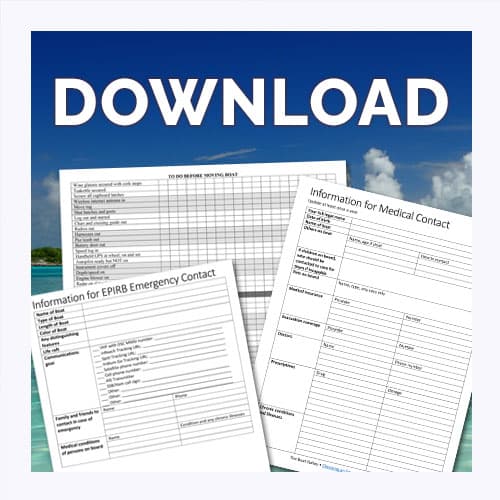
Find this helpful? Share and save:
- Facebook 359
- Pinterest 198
Reader Interactions
January 31, 2021 at 5:58 pm
I would think draft on the fixed keel boats would be important to many who are considering cats.
Carolyn Shearlock says
February 1, 2021 at 12:49 pm
I’ll see if we can perhaps add that.
Richard says
February 9, 2021 at 11:03 am
Good addition. I have provided drafts to Carolyn, so please watch this article for that to be updated. Any questions or additional information you would like added please comment again.
Drew Frye says
February 20, 2021 at 11:46 am
The best way to look at speed ratings is the PHRF rating or other handicaps. I used to own a PDQ 32 and never found a Gemini I couldn’t pass rather easily on autopilot, so I don’t think it rates slow if well handled. Granted, mine was turboed a bit and carried a 120 rating.
Florida ratings, according to US Sailing
PDQ 32 135 Seawind 1000 137 PDQ 36 156 Gemini 105 MC 168 Snowgoose 250 The others rate around 130-145
And of course, this is only fast or slow within the class. Fast multihulls cruising (?) multihulls rate 0-60.
February 21, 2021 at 7:59 am
Thanks! Good info.
September 10, 2023 at 5:55 am
I have an Edel 35′. For their price, they are a good option, for this size of catamaran. They are not slow, by any means. Disadvantage: clearance under nacelle.
Erin Michaud says
February 23, 2021 at 10:22 am
Great info, we met an owner of a Catalac 9M in Key West Garrison Bight Marina a couple of weeks ago. His name is Eric & he moved his boat to the Boca Chica Navy Marina. I will send the contact info for Rick to him specifically for the Catalac boats! Thanks!
February 24, 2021 at 5:54 am
Catalacs are great boats. We saw a couple for sale around the time we bought Barefoot Gal but they were sold the same day they were listed so we didn’t get to even look at them.
January 6, 2022 at 11:32 am
Hello. I was wondering if you can identify this open catamaran which boasts a GRP cockpit with seating?
https://imgur.com/gallery/2wzUJmR
Bruce Bayne says
February 20, 2022 at 9:57 am
I noticed that the Privilege 37 and 39 were not mentioned in your 10 list of catamarans. Is there a reason? How do they stack up to the others with regard to speed and bridgedeck clearance?
June 6, 2022 at 10:44 am
Rayma Church says
July 31, 2024 at 7:27 pm
Last November we purchased a Fontaine Pajot power cat (MY4s) that is 37′ long and has a beam of 16.8″, with a draft of 2.6″ and a height of 15′ but is tall inside for my 6’5″ partner without having to hunch over. This means we can go under the lowest bridges on the Great Lakes leg of the Loop, although we do not have a fly bridge. This is a new model (made its debut in 2023) and we plan to start the Great Lakes leg in June 2025 – the boat is being handed over to us in Annapolis in October. One of the reasons we selected this boat is because of the need for interior height but exterior “shortness” to get under the bridges. Also, this model has access on both sides of the boat that are about 18″ wide – another safety feature as my 6’5″ man has size 14 feet! We have been receiving your emails for the last 9 months or so in preparation for so many things boat related. We are both so happy to crib off of your experience rather than learn through adversity! Thanks, rayma
August 1, 2024 at 12:26 pm
Great choice of boat for the Loop!
Leave a Reply Cancel reply
Your email address will not be published. Required fields are marked *
Each week you’ll get:
• Tips from Carolyn • New articles & podcasts • Popular articles you may have missed • Totally FREE – one email a week
SUBSCRIBE NOW
- Questions? Click to Email Me
- Visit Our Store


How To Sail a Small Catamaran (Complete Guide)
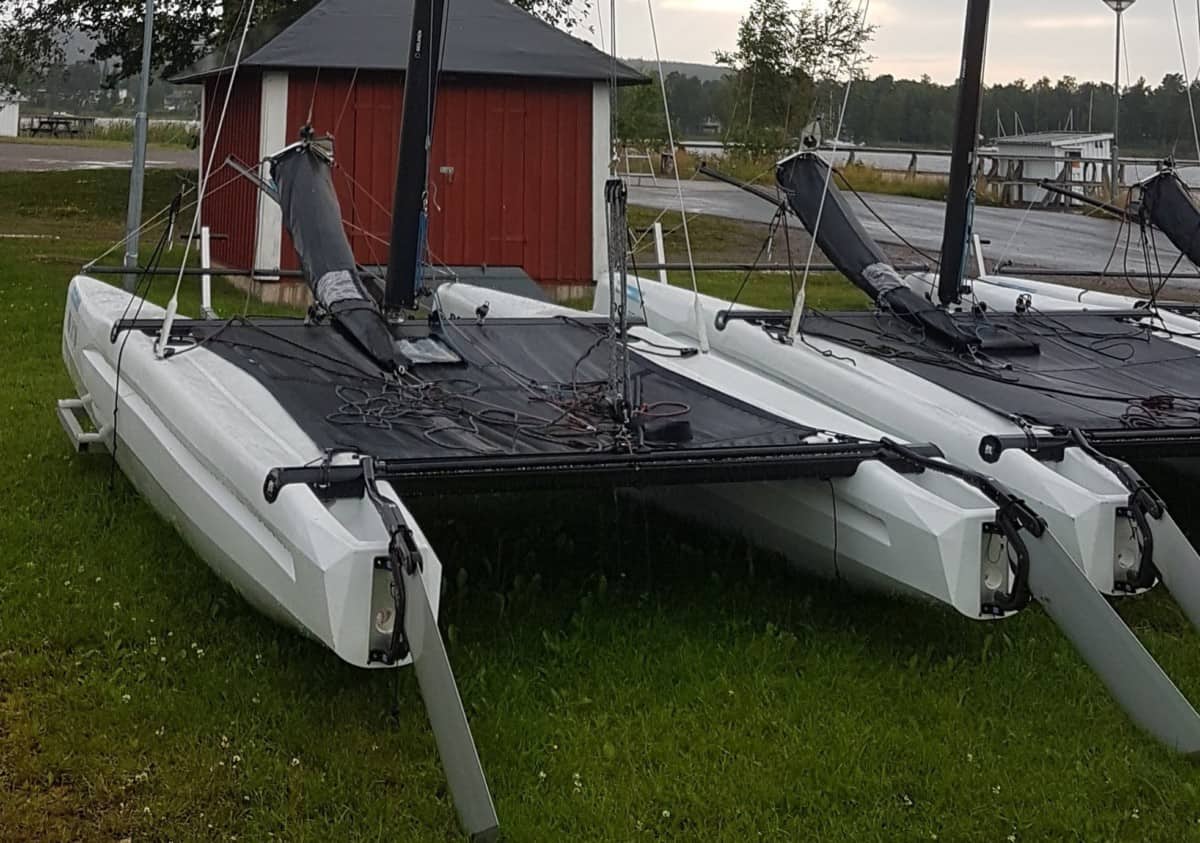
As an Amazon Associate, we earn from qualifying purchases. We may also earn commissions if you purchase products from other retailers after clicking on a link from our site.
Learning how to sail a small catamaran(also known as beach cats) can be the beginning of a new and exciting chapter in your life. It gives you the freedom to comfortably explore the waters, which offers a stimulating and relaxing sensation. If you’re interested in learning how to sail, it is advisable to start with a small catamaran.
To sail a small catamaran (beach cat), first, familiarize yourself with the catamaran’s essential parts and common sailing terminologies. Understand how it works and equip yourself with the necessary sailing gear. Additionally, you’ll need to understand the points of sail, how to steer, turn, and stop the cat.
This guide outlines what you need to know about sailing a small catamaran. Read on to learn more on:
- What is a catamaran?
- Understanding how a catamaran works
- Getting equipped
- Sailing basics
Looking to buy a small catamaran? Read my article Best Catamarans For Beginners
Table of Contents
Understanding a Catamaran
The first step in learning how to sail a small catamaran is to understand its essentials. We begin by looking at what a catamaran is, its essential features, and some standard sailing terms. Understanding the necessary parts of a cat and sailing terminologies helps with communication when sailing.
What Is a Catamaran?
A catamaran is a famous multi-hulled water vessel that features two parallel hulls and sails. Catamarans vary in size and shape, depending on the model and design. However, here we’re looking at the small catamarans (a.k.a. beach catamarans) and how to sail them.
Parts of a Small Catamaran
Below are the essential parts of a catamaran regardless of its model or design:
- Hull : It is the main body of the cat. It has a symmetrical shape, which reduces the drag caused by water friction.
- Tiller : It is a handle or bar that turns the catamaran’s rudder.
- Rudder : An underwater vertical moving board often turned using a tiller (or steering wheel) to initiate movement.
- Keel : It is a centreline attached below the hull running from the front (bow) to your cat’s back (stern). The keel offers stability to the cat and reduces the chances of it capsizing.
- Mast : A long pole set upright from the center of the boat to support the sails.
- Mainsail : It is the most critical sail on a cat that is attached to the mast.
- Foresail : Also known as the jib. It is a sail that fits into the foretriangle of the mast.
- Boom: This is a horizontal pole attached to the mast used for extending the foot of the mainsail.
A full interactive guide on catamaran parts explained ?
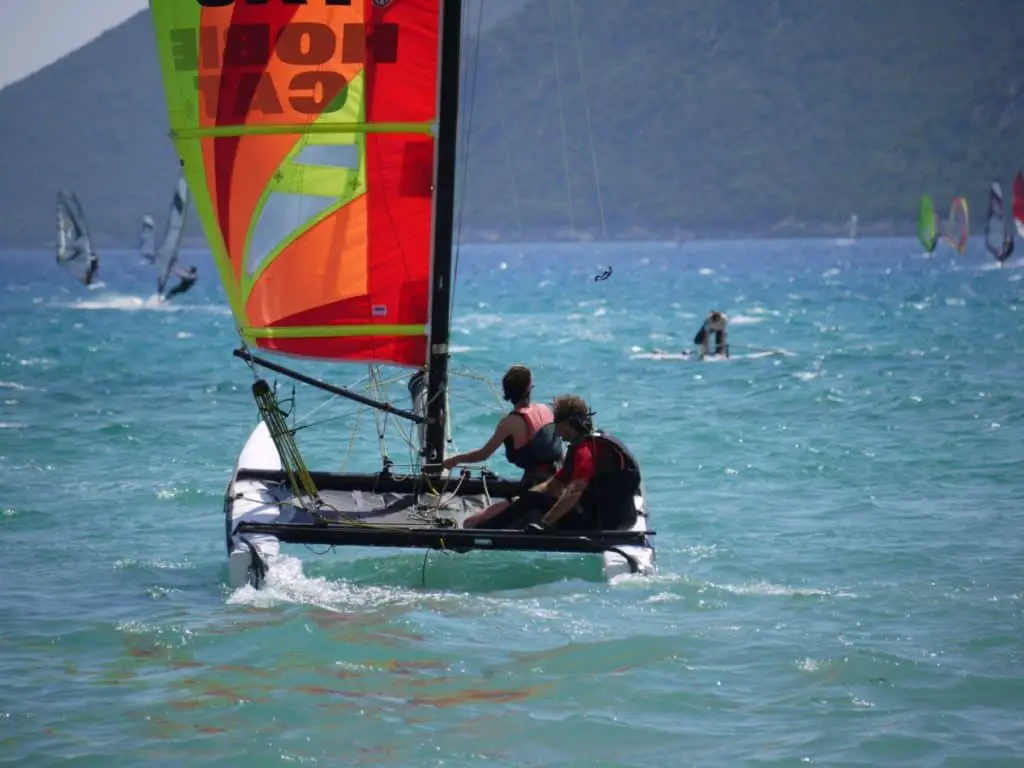
Common Sailing Terminologies
Now let’s look at some terms to add to your sailing vocabulary.
- Point of sail : The direction of your cat relative to the wind.
- Port : When facing forward, your cat’s left side is referred to as the port.
- Starboard : Refers to anything to the right of your cat when you are facing forward.
- Bow/ stern : The front and back of the catamaran, respectively. Additionally, you can refer to the bow as ‘forward’ and the stern as ‘abaft/ aft.’
- Tack: Changing the direction of your cat by turning the bow through the wind.
- Jib (gybe): Turning the stern of your cat through the wind to change direction.
- Heeling: A situation where the wind pushes your cat as it leans over in the water.
- Windward: The side of your catamaran that is closest to the wind. It can also be defined as the direction upwind from the point of reference.
- Leeward: The side of your cat far away from the wind. It is the direction of a cat upwind from the point of reference.
- Aboard: On or within the catamaran
- Halyards : Ropes used in raising or lowering the sails on the mast.
- Sheets: Are ropes that control the angle of the sails relative to the wind’s direction.
- Tacking vs Jibing Explained
Learning How a Small Catamaran Works
After gaining knowledge of parts of a cat and the common sailing terms, the next step is to understand how the catamaran works. Here, we’ll look at how the wind gets your catamaran moving.
As the sail of your small catamaran fills with wind, it forms an airfoil that propels your cat. Your sails play the most significant role in keeping your cat moving. As a result, you have to pay much attention to their positioning relative to the wind.
You start by raising the sails using the halyards. The mainsail (the sail closest to the stern) should be raised first, followed by the jib (the sail closer to the bow). With your sails raised, you should then trim them relative to the direction of the wind. By trimming your sails, you position them at an angle where they capture more wind.
As a newbie, you should first learn raising and trimming the mainsail before the jib because you will use it more when sailing your small catamaran.
However, you should note that you don’t rely solely on the sails and the wind to get your catamaran moving. You should also use the tiller to move and control the rudder. This way, you will be in a position to angle your cat in your preferred direction.
As you continue sailing, the wind’s direction keeps on changing. As a result, you should use sheets to trim your sails while tacking and jibing with respect to the wind’s direction changes.
Getting Equipped
After learning how a catamaran works, you are a step closer to practicing in the waters. However, before this, you need to prepare yourself by getting the right sailing gear. Your instructor should advise you on the right clothes and safety equipment.
Here are some items you should not leave behind:
- Shoes : You’ll need a pair of fitting shoes that you can comfortably use on the deck. They should be grippy and non-marking.
- Gloves : It is also advisable to have quality sailing gloves. They should be comfortable to wear and also allow you to control the tiller and perform other duties on board. Consider getting heavy-duty and breathable gloves.
- Sunglasses: You’ll also need good polarized sunglasses that will protect your eyes from the glare. When learning how to sail, it is essential to see how the water is moving. This helps in learning how to read the wind.
- Windbreaker : Do not forget a piece of clothing that will keep you comfortable even under windy conditions. It should be warm and waterproof.
- Logbook: You’ll also need a book where you can keep all your sailing records. You can indicate how many sailing classes you’ve taken, the number of hours you’ve sailed, and the waters, shallow or deep.
- Compass / GPS : Don’t leave behind a compass and a map. These come in handy when you want to find a bearing or are lost in the sea.
- First aid kit : When packing your essentials, don’t leave behind a first aid kit. As a newbie, you might have sea sickness during your first sailing sessions. Carry a kit with the right prescriptions.
- Finally, do not leave behind a phone and a power bank, plus enough food and water.
After preparing yourself for sailing, you should also prepare your small catamaran.
Preparing the Catamaran
Preparing your beach catamaran for sailing involves analyzing its parts and studying the prevailing weather conditions.
Perform a Physical Check
First up, conduct a detailed physical check to see if all the parts are in their stable working conditions:
- Check if the tiller is moving freely to control the rudder.
- Look at the condition of your sails. Ensure they are straight and with no holes or frayed edges.
- The rigging should be in their perfect working conditions. Check the standing rigging (everything that keeps the mast and sails upright) and the running rigging (the lines used to raise and control the sails).
- Check all lines . They should be free. This means they should not be wrapped against each other or around any objects aboard. Here you may also need to tie line knots if you intend to use them during your sail.
Study the Wind
Before getting into the waters, you’ve to study the direction of the wind. Knowing how the wind is blowing helps in the proper positioning of the sails and the cat. You can check the wind’s direction by looking at wind instruments in your small catamaran.
Most catamarans have wind indicators strategically placed on their mast. You can use this. Additionally, you can tie small flags on the sides of your cat to help with the direction. Knowing where the wind is coming from allows you to position your cat at the right point of sail.
Points of Sail
The point of sail defines the direction of the wind relative to your cat. With the right point of sail, you will be in a position to sail your catamaran smoothly. The point of sail differs depending on the angle of your cat from the wind. The different points of sail include:
- Running : In a running point of sail, the wind blows behind your back. It is not advisable to use this point of sail as accidents are prone to occur if the wind’s force pushes over your small cat.
- Broad reach : The wind is partially at your back and your side (aft quarter).
- Close reach : Here, you are sailing at approximately 60-75 off the wind.
- Beam reach : You position your cat at an angle of 90 of the wind. It is considered the most precise sailing position.
- Close haul : At this point of sail, you are approximately 45-60 off the wind.
Hoisting the Sails
Now that you have already identified the wind’s direction and positioned your cat, the next important thing is hoisting the sails. While hoisting your sails, it is advisable to start with the mainsail.
- To start with, secure the bottom front of the mainsail to the respective shackles on the boom.
- Notice a small line known as an outhaul that attaches the clew (the lower back part of the mainsail) to the boom. Carefully pull it out until the mainsail forms a smooth airfoil allowing wind to blow over it.
- Now pull down the halyard until it stops . You will notice some flapping on the mainsail, which is normal.
- Ensure that the mainsail’s edges are smooth , then attach the halyard on the winch or cleat.
- Now shift to the jib and hoist it . Start by securing its bottom front part to the boom and then follow a process similar to that of hoisting the mainsail.
Start Sailing
As a newbie, you need to ensure you are on a safe sailing point during your practice sessions. Avoid going far into the waters with your small catamaran during your first training sessions.
Also, ensure that you have enough space around you for your catamaran to turn in response to the wind movements. This is to avoid being thrown back into the dock or in the sand by the moving wind.
As you start sailing, you’ll notice the effects of the wind on your cat. As a result, you may need to make a turn through tacking or jibing .
When sailing, always make sure you place yourself at the right point in your catamaran. Sit at the side where the wind is blowing to; the wind should blow from your back. This means you should be on the opposite side of the sail and not beneath it. Sitting on the wrong side might cause your cat to flip over.
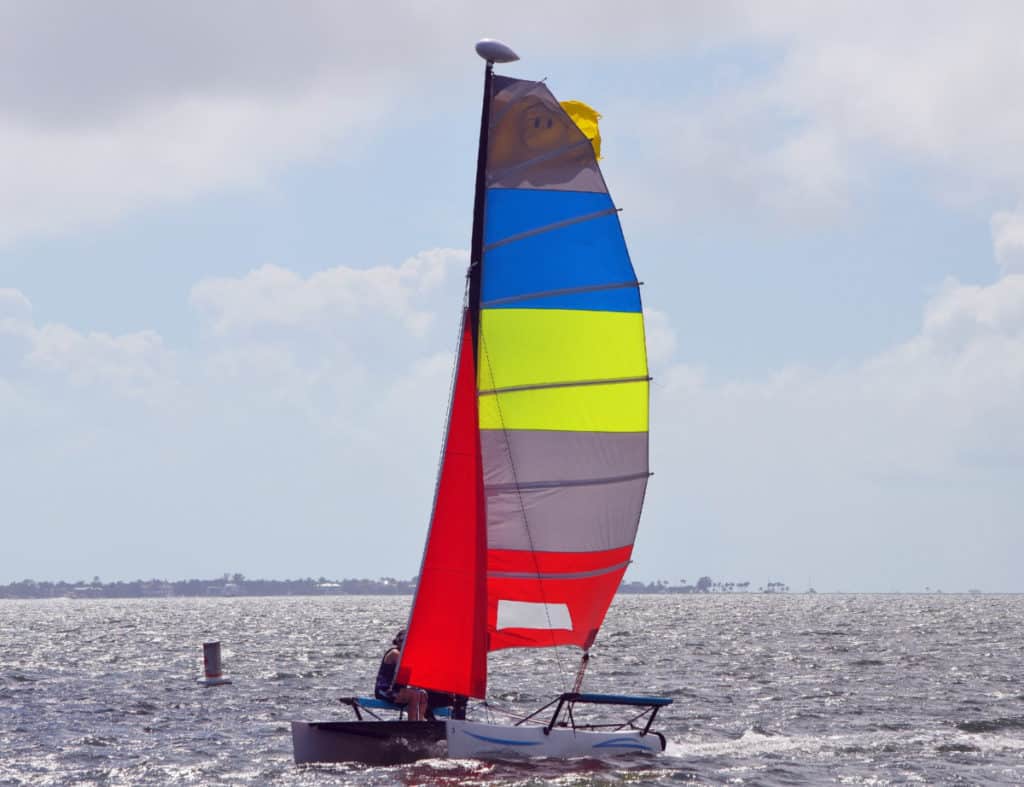
Now that you already know how to get your cat moving, let’s look at steering. Steering the cat is often unclear to most newbies.
Small catamarans are steered using a tiller that controls the rudder. What confuses most sailors is that you move the tiller in the opposite direction from which you want your cat to move. So, if you’re going to turn to the right, you will push your tiller to the left and vice versa.
Since steering a small cat differs from steering other moving vessels, the experience may feel awkward at first. However, you shouldn’t feel pressured to master it all at once. Take your time and practice until you master the process.
Trimming the Sails
As you continue learning how to sail, you also need to understand how to control your cat by trimming sails. Trimming sails means adjusting the positioning of your sails to control the movement of your cat.
As a learner, to effectively and safely trim your sails, you should first position your tiller to reduce the movement of your cat to either side. Start by trimming the mainsail.
Tighten the mainsail to stop flapping and for it to take a new shape relative to the wind’s direction. As your mainsail takes a new form, your cat will start building some speed. Quickly grab the jib and adjust it too.
To tighten the jib, stretch it as much as you can to reduce flapping/ luffing. Once the flapping has reduced, loosen it and let it out until the edge of its luff (the forward end of the jib) is shaking. Now tighten it back in its new position, and you are ready to go.
If you are sailing close to the wind, you have to keep your sails tighter than usual. On the other hand, if you are sailing off the wind, your sail should be left loose. Generally, tight sails cause your cat to move faster, while the opposite is true for loose sails.
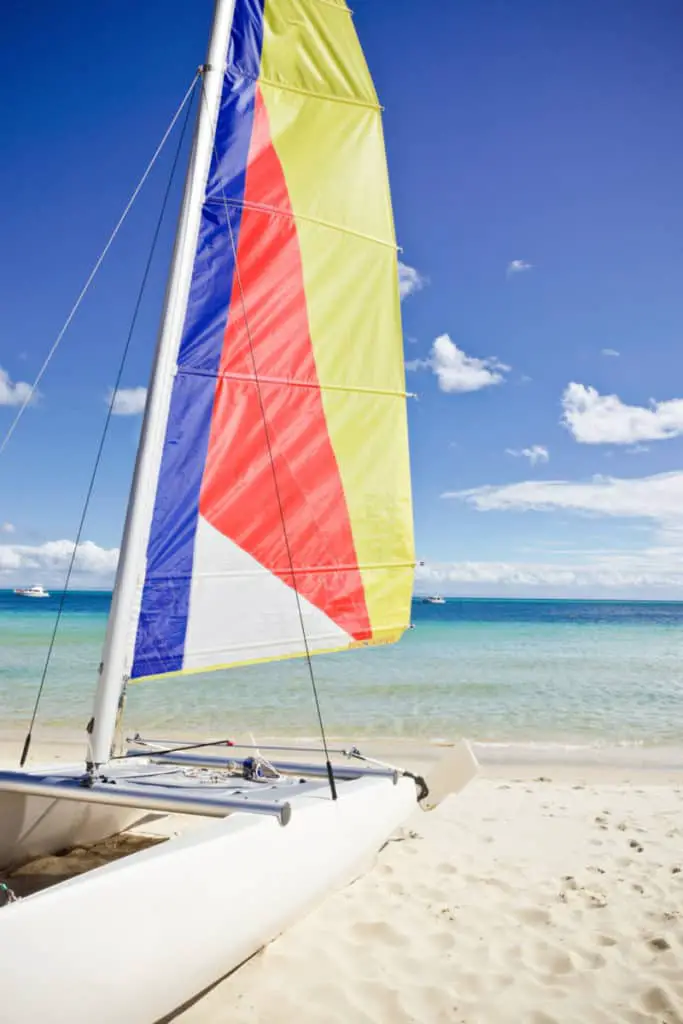
Turning the Catamaran
You’ll also need to learn how to turn a catamaran. As a learner, after releasing the mooring line, you should be prepared to turn the catamaran by moving the boom to either side. As you push out the boom, the wind will hit your sail from the back, making your cat turn.
Therefore, you should be cautious enough to avoid turning in the wrong direction. Like in moving the tiller, you also push out the boom into the opposite direction you want to turn. Therefore, when turning to the right, you push out the boom to the left and vice versa.
Slowing Down and Stopping
Although sailing a small catamaran at high speeds is fun, you may at some point want to slow down. When you detect an obstacle in the water, you may need to slow down. Most sailors use the term ‘spill wind’ to refer to the action of slowing down and stopping a cat.
Since tighter sails often accelerate the speed of your cat, you can slow it down by loosening them a little. The more you let your sails out, the more your cat slows down and eventually stops.
It is advisable to release the sails as you face the wind’s direction to help your cat stop. If you are sailing against the wind, first turn your cat in the direction of the wind, then release the sails.
Practice slowing down and stopping your cat under different weather conditions to be prepared in case of an emergency. Since your cat has no brakes, you should practice this until you perfect your skills.
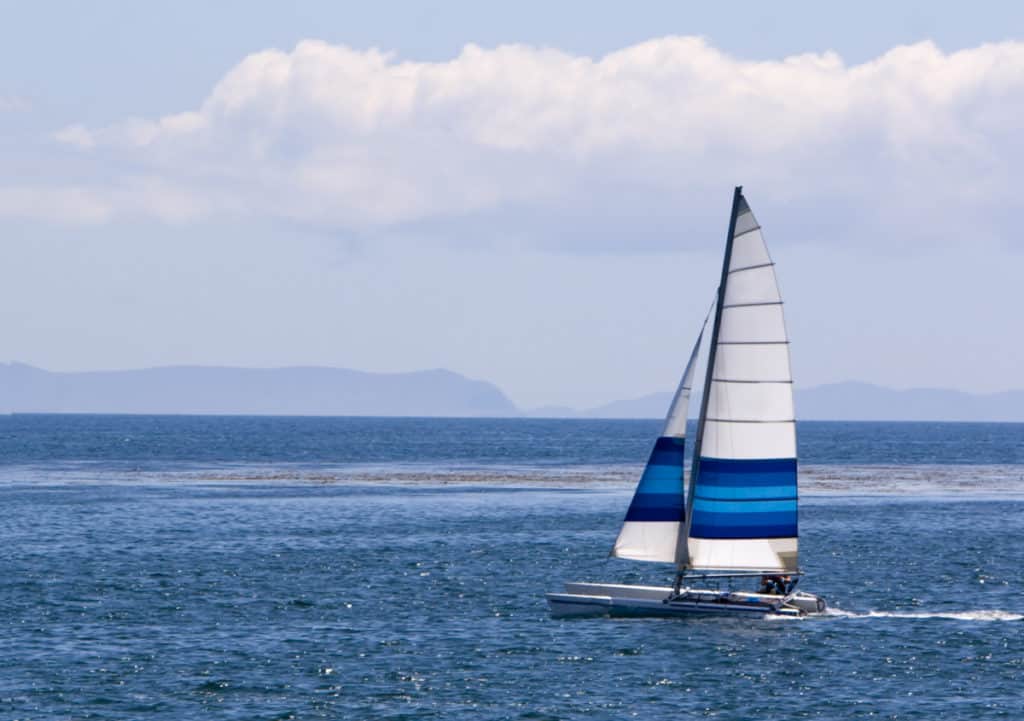
Capsize Recovery
Although capsizing is not common in catamarans, it can happen and it is crucial always to be prepared. If your small catamaran capsizes, it is advisable to start the recovery process immediately before the situation worsens. Let’s look at how to right a capsized catamaran.
Why and how often do catamarans capsize, a scientific approach!
You can right most small catamarans by pushing the bow or stern below the water to rotate them upright.
To right your capsized catamaran:
- Lower down your bow and stern until your cat lies in a vertical position.
- One crew member should then swim around to one end of the lower hull and then push it down. By pushing the lower end down, the uppermost hull’s end comes down towards the water.
- As the uppermost hull drops towards the water, it is pulled down by another crew member. In the meantime, the other crew pushes the cat up midway along the lower hull.
- This movement puts your cat in a vertical position in the water. The crew members then swim to the mast and push it back to its standard sailing position. They then climb aboard fast before the cat sails off.
Avoid sailing alone. Always have some crew members to help you out in case of a capsize.
Learning how to sail a small catamaran is a process that requires practice and patience to perfect your skills. Therefore, don’t feel pressured; take it slow, a step at a time. Start by understanding the essentials of a catamaran, preparing yourself and your cat for the adventure, and learning some sailing basics.
The fundamental sailing basics outlined in this guide are the points of sail, steering, trimming sails, slowing down, and righting a cat after a capsize. Follow our guide today and become a pro in sailing a small catamaran.
- Catamaran Parts Explained
- Why do catamarans capsize?
Owner of CatamaranFreedom.com. A minimalist that has lived in a caravan in Sweden, 35ft Monohull in the Bahamas, and right now in his self-built Van. He just started the next adventure, to circumnavigate the world on a Catamaran!
Leave a Reply Cancel reply
Your email address will not be published. Required fields are marked *
Save my name and email in this browser for the next time I comment.
Recent Posts
Must-Have Boat Gear for Catamaran Sailors!
Sailing is probably the most gear-intensive activity I've ever done; there are so many decisions to be made about what gear to buy now, for tomorrow, and what to definitely never buy. The gear on...
6 Best Trailerable Trimarans For Bluewater and Coastal Sailing
Having a boat costs a lot of money, even when you are not using it, marina fees, etc. And once it is in the water most sailors never go very far from their "home marina" and sailing will be somewhat...
Smart Cat S280
The ultimate fun & practical sailing catamaran, introducing the smart cat s280 – a revolutionary sailing catamaran designed to exceed your expectations. with its sensational design, innovative features, and compact, low-maintenance build, this boat offers an unmatched sailing experience. enjoy a spacious deck and lounge area perfect for living aboard with complete privacy..
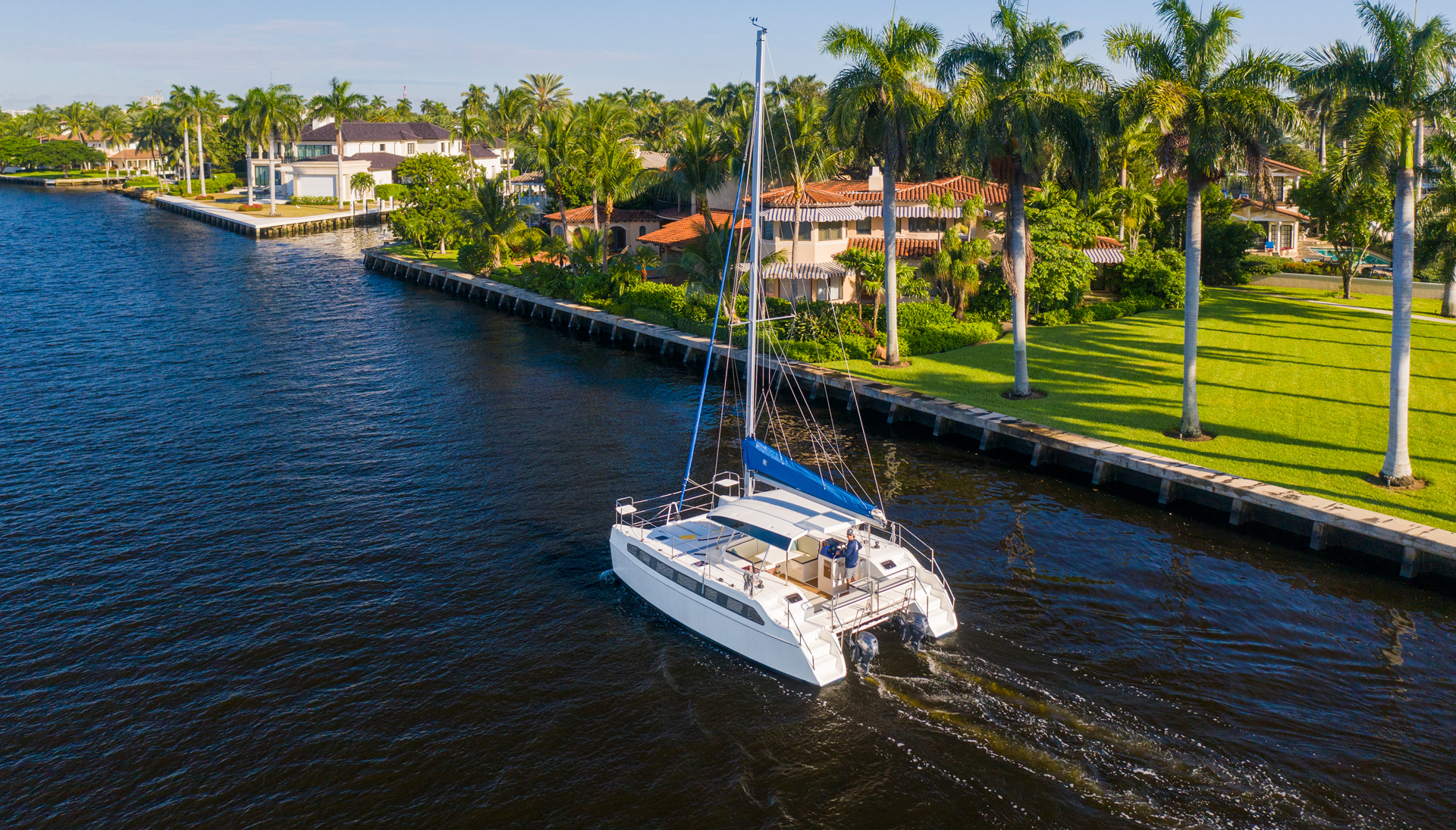
ENDLESS FUN
Whether you’re sailing with a small family, a large family, or a group of friends, the Smart Cat S280 has you covered. Its expansive and comfortable deck provides the ideal playground for everyone. The shallow water-friendly hull allows you to explore shallow waters, islands, intercostal areas, bays, and sandbars with ease and freedom.
PRACTICAL DESIGN
The Smart Cat S280 is equipped with everything you need for a perfect sailing adventure. Its open deck is both spacious and functional, allowing you to sail and party simultaneously. The compact size makes maneuvering and docking stress-free, giving you more time to enjoy the journey.
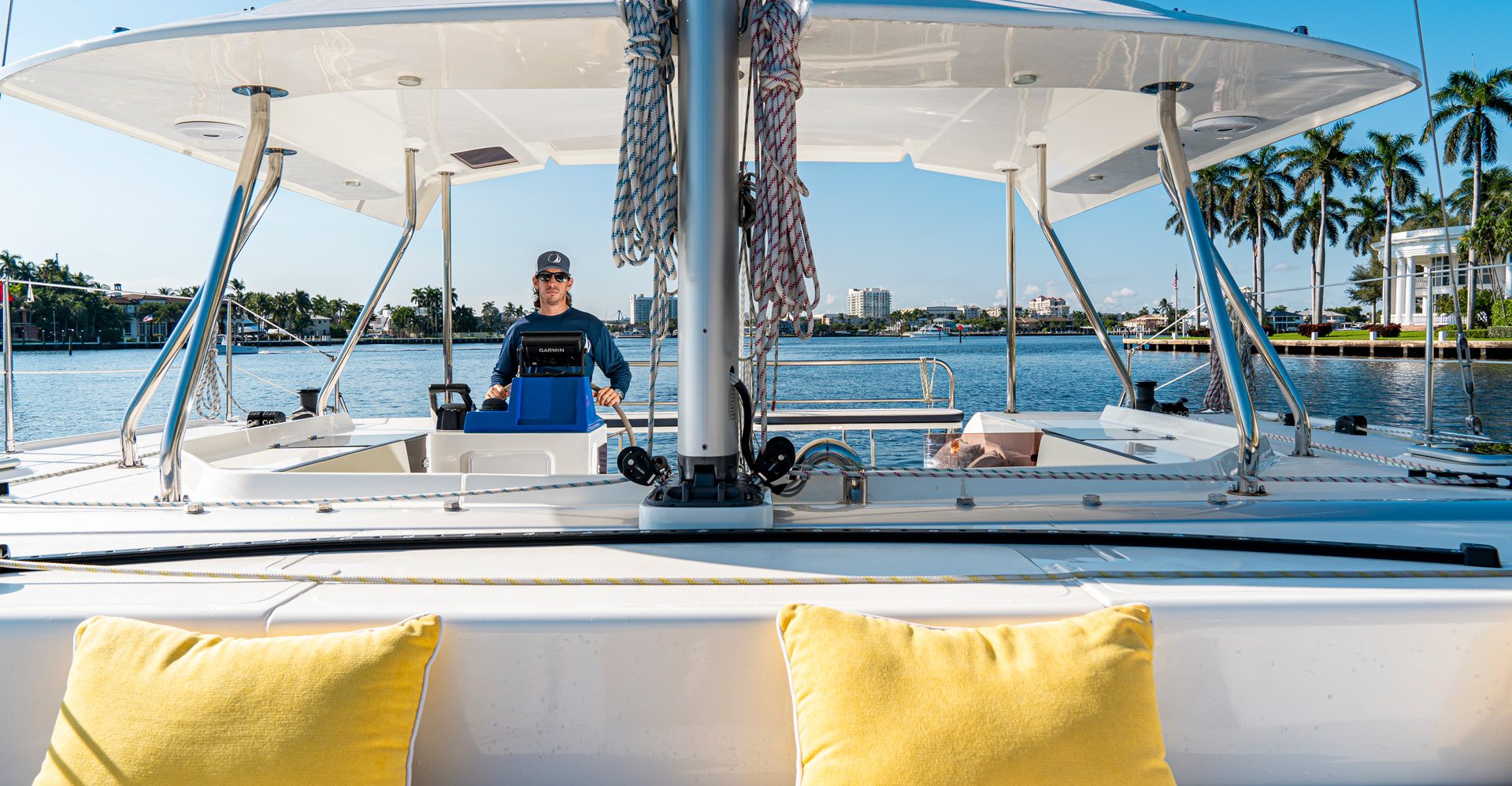
AFFORDABILITY
While catamarans are often expensive, the Smart Cat S280 offers an affordable alternative. Not only is the initial cost reasonable, but the maintenance costs are also exceptionally low. You won’t need a big marina or a crane for servicing – its simple systems are easy to maintain and service.
LIVEABOARD COMFORT
The Smart Cat S280 is the smallest sailing catamaran with a liveaboard design and layout. Inside, you’ll find ample space featuring three queen-size berths, a head/shower, a kitchen, and an office space. Enjoy comfortable living aboard with perfect privacy, making every voyage a home away from home.

EASY SHIPPING
Shipping is quite tricky and costly for catamaran boats because of the larger volume. However, we developed new way to assemble the boat so it can be shipped with two units of 40ft HQ container to anywhere worldwide with low cost.
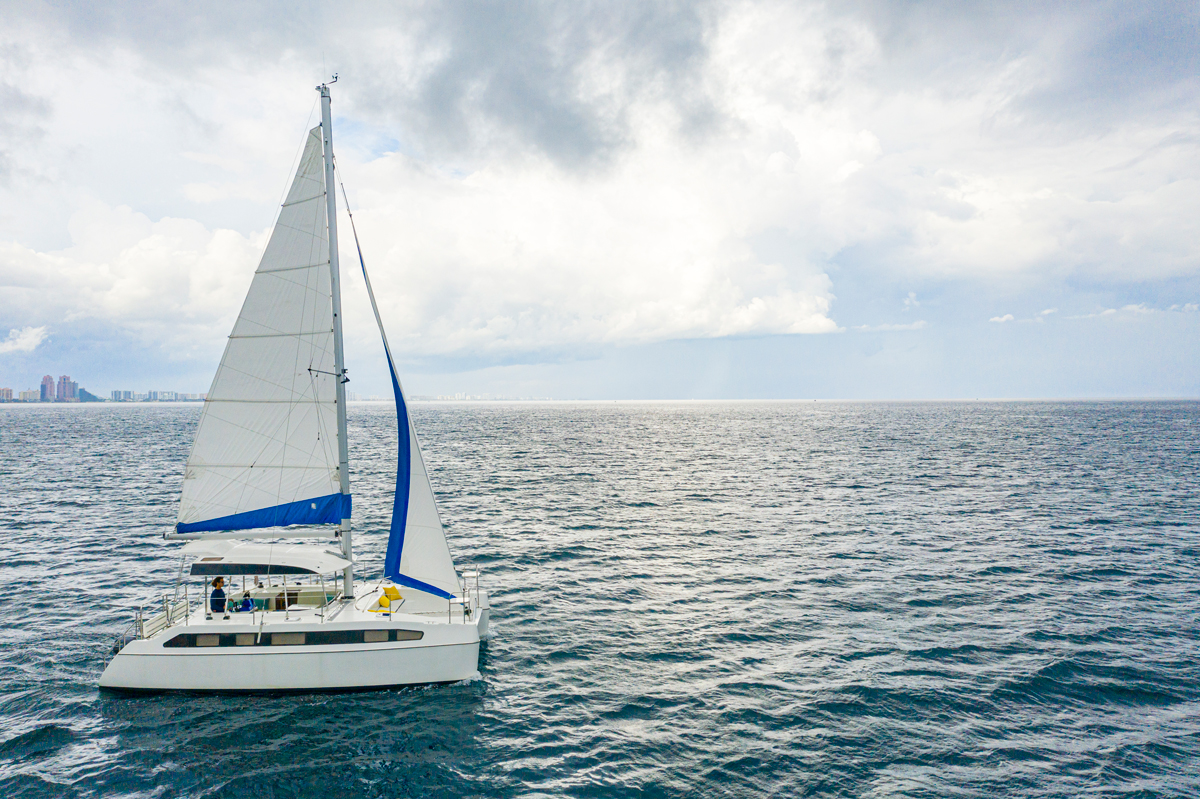
Hard Top Options
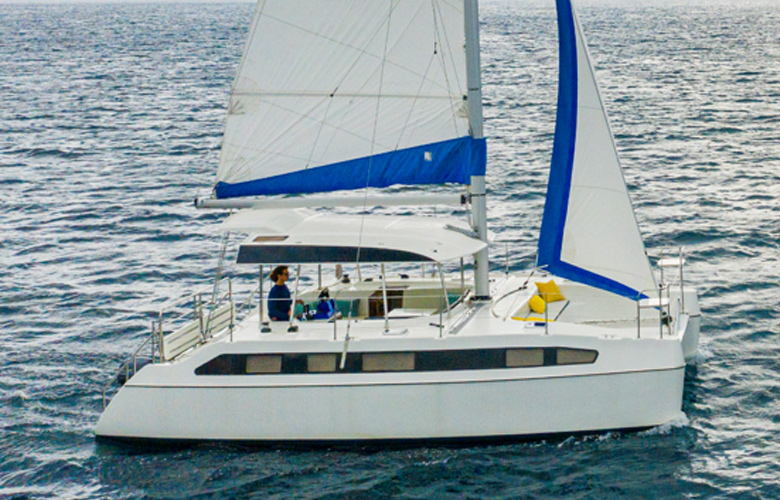
- Perfect for tropical weather
- Convenient to accommodate larger number of passengers

- Good protection for climate changes
- More privacy for liveaboard usage
Layout Options
3 cabins and 1 head.
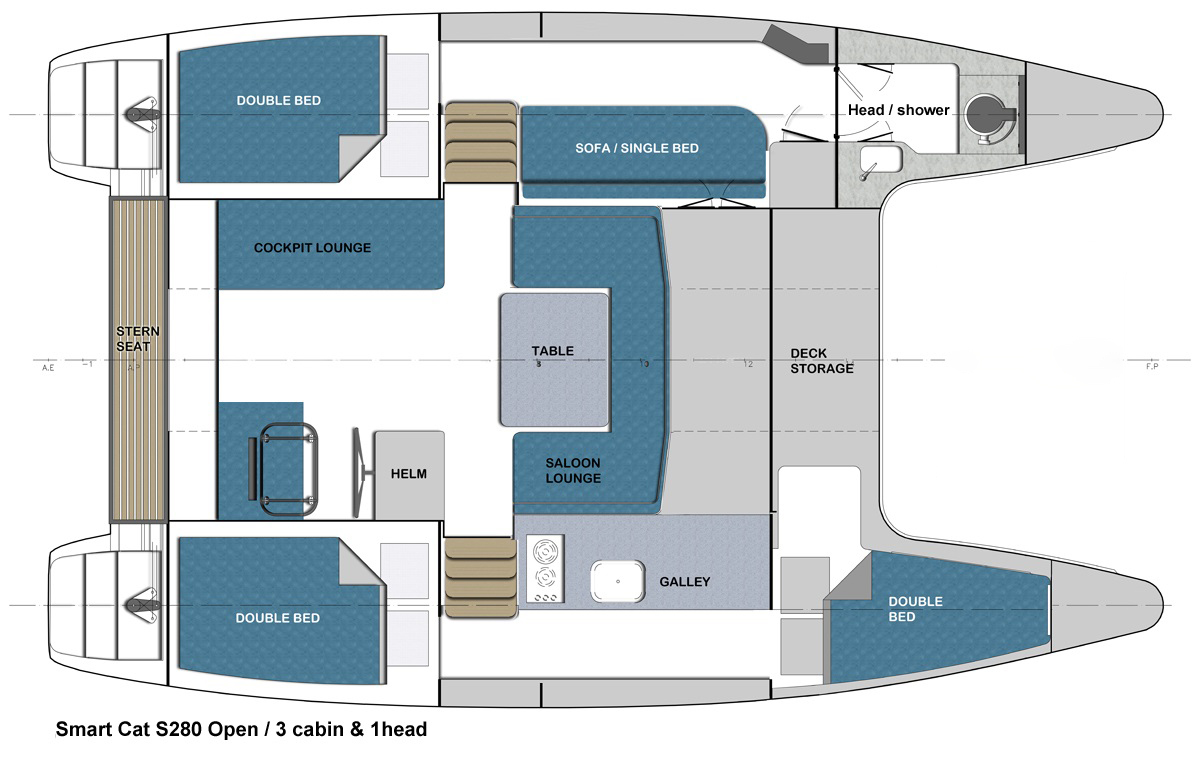
2 Cabins and 2 Heads
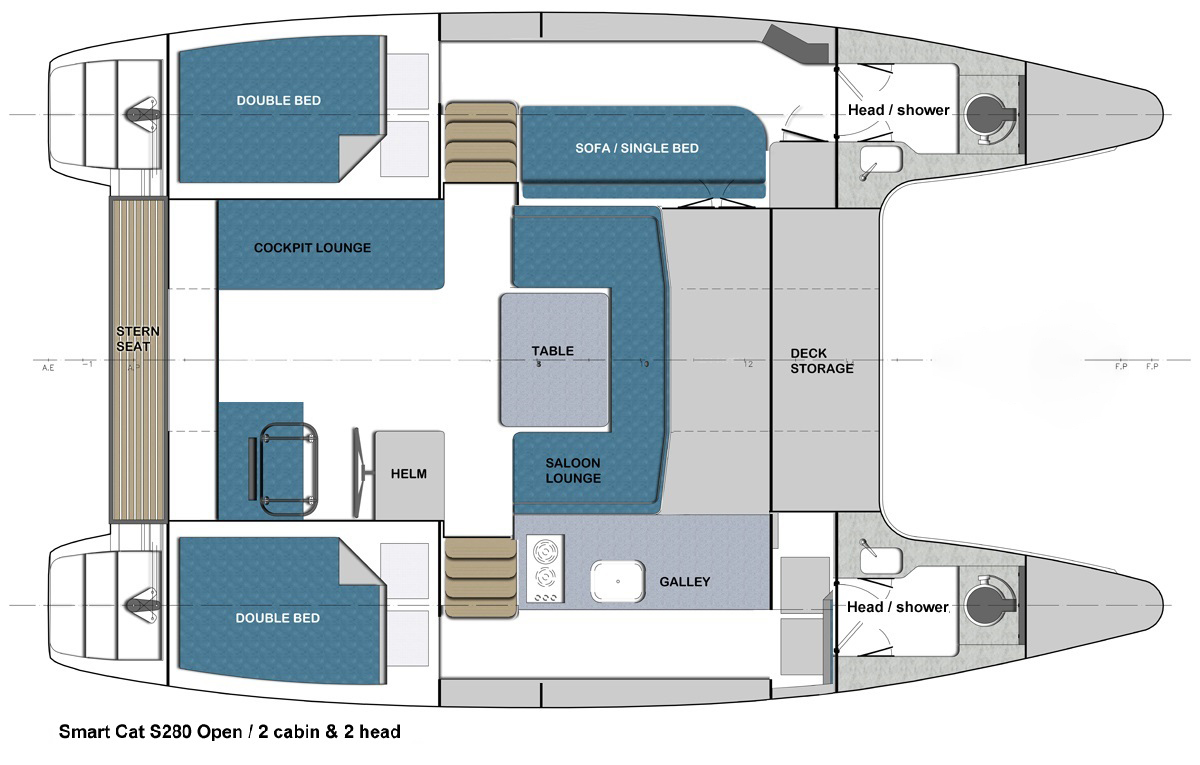
Engine - Standard (hp)
Engine - optional (hp), fuel tank (l), fresh water tank (l), specifications, displacement.
10,000lbs / 4.5tons
27Gal / 102L
Clearance Between Hulls
7ft-2in / 2.18m
17ft-5in / 5.29m
Main Sail Area
417sq.ft / 38.8sq.m
Fresh Water Tank
36Gal / 135L
2ft-10in / 0.89m
Jib Sail Area
174sq.ft / 16.2 sq.m
Holding Tank
23Gal / 88L
Bridge Clearance
46ft-3in / 14.10m
Genoa Sail Area
344sq.ft / 32sq.m
(2) x Yamaha 9.9hp (Standard)
(2) x Yamaha 25 hp outboard (option) (2) x Yanmar 21 hp Inboard (option)
Testimonials
John Dial The Smart Cat was such a pleasant surprise! When I first heard of the boat, I was skeptical. When I saw the boat, I LOVED it! I am an experienced boater with over 30 years hands-on with all brands of boats both sail and power. I went on the boat alone with no salespeople and had the time to study the quality of the boat, all of the hardware was comparable to any of the other quality-built boats I had been on as was the fiberglass and gel coat. The space utilization was amazing, and the interior well thought out… USCG Master Captain / United Yacht Sales
Ben Kaminsky One of the most interesting boat exhibiting at 2020 Miami Boat Show. The boat handled very well. The ride was pretty comfy due to the high length/beam ratio. I was pretty impressed with how it handled and performance was good for this kind of catamaran range. Catamaran Review
Learning the Lines I think it’s a really cool boat. I think this boat would be good for coastal cruising, week-ending and fun all-around boat. For 28 foot boat, this boat has a ton of accommodation. There is a lot of living space even though it’s just a 28 foot boat. This boat is very beamy which is… Youtuber
Questions/Inquiries
- Price Sheet
BROCHURE – SMART CATAMARANS
OPTION & PRICE LIST – SMART CAT S280 SAILING
- The magazine
Current issue
- All the issues
- My magazines
- Technical specifications
- Multihull of the Year
- Classified Ads
- Destinations
- Online store
- All the magazines
- Subscriptions
- Accessories

MiniCat 420
Given the boom of the RIB market and inflatable paddleboards too, it’s no wonder that small catamarans are also taking a look at the formula. The big leader in this niche, MiniCat will soon be celebrating its 15th birthday and... 2,000 catamarans produced! We tried out the most popular model from the Czech manufacturer, the MiniCat 420.
Practical info
- Builder : Minicat
- Finance your MiniCat 420
- Articles about the MiniCat 420
- Available in issue # 174
Boat Test price 5.00 € Inc. tax

Add several tests to your cart
and get an extra discount!
Some large multihulls with clear space on the bimini have been known to carry a pair of Optimist sailing dinghies on the top - although the windage would be substantial and stowing as well as launching wouldn’t be an obvious task. Surely, it’d be simpler to take a small sailboat that fits in two bags? And why opt for a small monohull capable of capsizing in the first puff of breeze when you are a multihull enthusiast? MiniCat - or rather its founder, the Czech Martin Horak - became interested in the idea of an inflatable catamaran 14 years ago. His goal was to offer a real sailing boat, easy to assemble and transportable in simple bags. The MiniCat can be easily stowed on board, but also in your car. You can therefore be the owner of a catamaran that slips under your bed! The range starts with the 10 feet (3 m) Guppy and extends up to 15 feet (4.60 m).
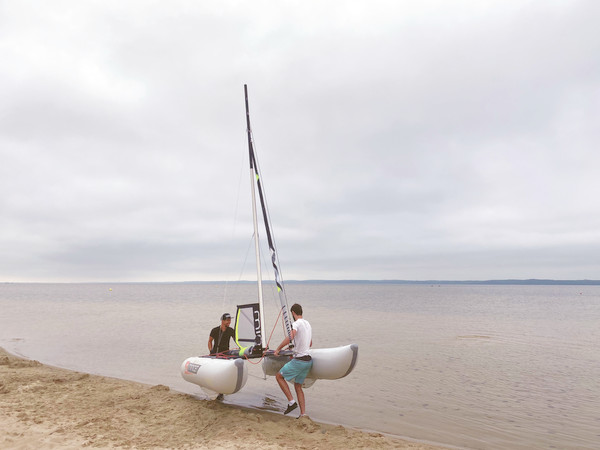
It fits in two bags!
The MiniCat 420 fits in two bags of 5’9”x12”x12” (175 x 30 x 30 cm) - they are designed to fit in a standard car by folding just one seat. Each bag weighs just over 50 lb (25 kg). Optionally, they c...
To read in full, Buy the boat test
What readers think.
Post a comment
No comments to show.
MW #197 - Oct / Nov 2024
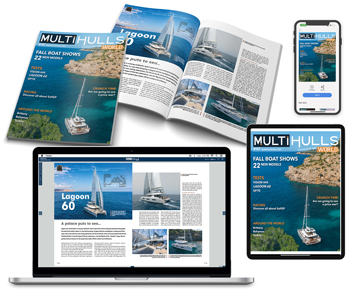
Download all the Boat Tests
Over 500 multihull tests
Boat tests from the same builder

MiniCat Guppy
- Minicat Guppy
Place a classified ad Free of charge
on Multihulls World
Boat tests from the same range

- Tricat 25 Evolution

- Aventura 28
Classified ads

PRIVILEGE 435 refited 2023

Catamaran ORC 42 n°20

Nautitech 48 0pen Available
Vous avez ajouté " " à vos favoris., vous avez supprimé " " de vos favoris., in order to add this article to your favorites, please sign in..

CraigCat E2 Elite

Since 1990 the patented CraigCat horizontal Catamaran is unique in form and function. Super high quality and made of only the finest materials available, and built in Orlando Florida. This state of art craft not only appeals to all ages, men and women alike, but defies the world of regular boats and personal watercraft. CraigCats are super stable, comfortable side-by-side seating, unsinkable and have an amazingly dry ride even in rougher conditions. Low maintenance and easy to use, all in a compact powerboat that you can tow with practically anything. Freshwater or saltwater, fishing or cruising, the CraigCat will amaze you! Discover the CraigCat difference for yourself, test drive one today!
Features With amenities that no other small boat on the planet has to offer! Convertible bimini top, full remote (steering, shifting and throttle), electric key start, electric engine tilt, custom deluxe bucket seats, twin docking lights, NAV lights, LED position light, LED courtesy deck light, high performance JBL saltwater rated AM/FM/USB/ Bluetooth sound system with twin HD 2-way waterproof marine speakers, fishing rod holders (4), custom composite full-width storage compartment, polished stainless steel beverage holders, splash-off and cooler.
E2 Elite Fully loaded (white and blue) Tohatsu 30HP – $13,985 | 25HP – $13,785, Mercury 30HP – $14,985
E2 Elite Fully Loaded Gulf Stream Edition (seafoam and white) Tohatsu 30HP – $14,484 | 25 – $14,284, Mercury 30HP – $15,484
E2 Elite Fully Loaded Tahitian (tan and beige) Tohatsu 30HP – $14,384 | 25HP – $14,184, Mercury 30HP – $15,384
E2 Elite Fully Loaded Key West Edition (yellow and red) Tohatsu 30HP – $14,384 | 25HP – $14,184, Mercury 30HP – $15,384
Custom Ez Loader trailer – $1,488
Specifications Speed: Up to 30 mph Length: 11’4”. On the trailer15’. Width: 5’5”. On the trailer 6’. Draft: (Engine full down) 13”, (Engine up) 3” Average full consumption: 1 gallon per hour. 6 gallon capacity. Weight: 550 LBS. On the trailer 800LBS. Rated Capacity: 250 LBS per seat, 600LBS total Power: Mercury, Tohatsu 30hp
E2 Elite model build sheet with prices. Click here to download.
Available in these styles: Click the bars below to see photos. Click on photos to enlarge.

E2 Elite - Click for Photos

E2 Gulf Stream - Click for Photos

E2 Tahitian - Click for Photos

E2 Key West - CLICK for PHOTOS

e2 CAMO - CLICK FOR PHOTOS

$975 / Exclusive Package Add-On
Exclusive Package- CLICK FOR DETAILS
Exclusive package.
CraigCat has taken cool to a whole new level! Introducing the Exclusive Package where high tech meets luxury. The Exclusive Package features high intensity LED NAV lights with a polished stainless steel finish, LED courtesy deck light, QUAD (4) super high intensity forward facing LED docking lights with port and starboard facing LED docking lights, top-of-the-line Infinity sound system – 3.5” color LCD display AM/FM/USB/Bluetooth/weather-band, additional HD rail mounted 2-way Kicker speakers (total of 8 speaker system), and custom exclusive badging.
- Upgrade any E2 Elite or Catch-it model with the exclusive series package: $975
(WE INSTALL TOHATSU AND MERCURY OUTBOARDS)
Save 10% on new Happy Cat Sailboats while supplies last Discount Code: EOYHAPPYCAT

MiniCat 460
Performs as good as it looks..
The MiniCat 460 is the largest and fastest in the MiniCat lineup. It fits a wide range of functionality with the ability to mount an outboard and a total weight capacity of 1,234 pounds! This is a great family sailboat, with a focus on speed and performance. It's also a great day sailor when you want to carry more weight and make better speed, especially in light winds. This boat turns into an absolute rocket ship when put into capable hands. The MiniCat 460 is a great value in performance beach cats.
The MiniCat 460 comes in 2 different trim levels: Esprit and Elite. All 460 models include a continuous line jib furler, traveller, and boomless mainsail. You can learn more about each trim level below.
MiniCat 460 Esprit

The 460 Esprit is a fantastically fast and efficient sailboat. Its mast is one section taller than the 420 mast and has a longer waterline which translates to a faster boat in all conditions.
MiniCat 460 Elite

The 460 Elite is everything the 460 Esprit aspires to be, but with carbon fiber bits for a more performance aesthetic. Don’t be fooled, the carbon mast isn’t just for looks; the carbon mast is much easier to step when assembling the boat, and it is much less weight aloft than the aluminum mast which allows you to carry full sails in stronger winds without a worry of capsizing.
Setup is easy! Click here to watch the full MiniCat 460 setup video.

Not the right sailboat for you? Let’s find your perfect boat.
MiniCat 460 Features & Benefits
The MiniCat 460 is a boat that combines premium and lightweight materials that allow you to spend time on the water without the need for a slip or trailer! This travel ready sailboat is perfect for fast solo sailing as well a safe and family friendly daysailer.

Dyneema Shrouds - Standard
Dyneema cordage is stronger than steel and soft on the hands. Dyneema also weighs less than steel. Less weight aloft = faster! Believe it or not, but these Dyneema shrouds will even stretch less under tension than stainless steel wire. This cordage is easier to stow (for faster take-down and setup of the boat).
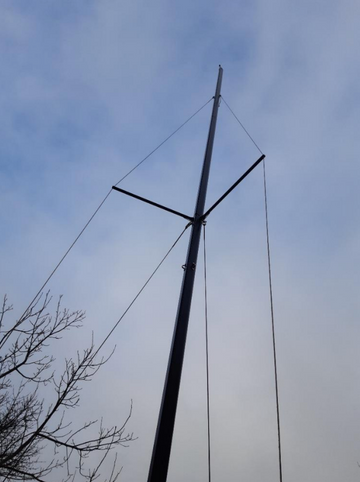
MiniCat has included spreaders on the mast of the 460. This is a major upgrade to rig tension of the boat. These upgraded spreaders will increase the available power on MiniCat's largest and most powerful model.

Tilt-Up Mast Step
A new option for 2024, a tilt up mast step will greatly reduce the stress and physicality of stepping the 460. The 460 mast is one whole section longer than the 420 mast, making it 25% heavier. This is a welcome upgrade that will allow you to buy the faster boat without signing up for a sore back while trying to step the mast.

Windowed Sails
The jib and main sails on the MiniCat boats all have windows in them. This allows you to be more aware of your surroundings. Even with the colorful sails, sometimes other boaters are not paying attention. These windows allow you to see 360° and be responsive to your surroundings.

Jib Travelers
Jib travelers are unique on an infaltable catamaran! These are a major upgrade allowing for more optimal sheeting angles of your jib. This means the MiniCat 460 will point much higher and be faster on more points of sail than the 420 and even competitor's sailboats!
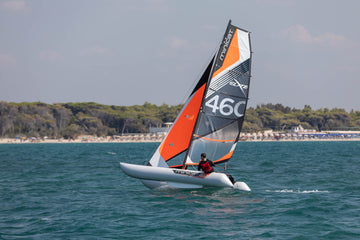
Fully Battened Square-top Mainsail
The square-top mainsail provides this beachcat with more than enough power to have a fun day on the water. Fully battened for superior sail shape, even in light winds. The 460 can easily reach speeds up to 18+ knots and some have even pushed their boat faster than 20 knots!

Heytex 5509 PVC
All MiniCats, including the MiniCat 460, have hulls made in Germany with Heytex 5509 PVC. This is top shelf PVC and has a longer life expectancy than typical boat PVC. This boat fabric is no different than other PVC with regards to repair. It is easily repairable by an amateur, so no more expensive boat yard repair bills! MiniCat now covers their hulls with a 7-year warranty!

Powder Coated Lightweight Frame
MiniCats are built with lightweight aluminum frames that have been powder coated using techniques that are time tested and durable. The rugged, long-lasting frame uses the lightweight and durable materials for both transport ease and sailing performance.

Jib Halyard Tensioner - Standard
The MiniCat 460 includes a jib halyard tensioner as standard equipment. This tensioner will allow you to increase your rig and jib luff tension significantly allowing for better pointing angles and better sail control.

Low Aspect Ratio Keels
The MiniCat 460 is equipped with long shallow keels under each hull which contribute to the MiniCat’s ease of use and great sailing characteristics. The keels allow the 460 to be sailed in very shallow waters. Only fly a hull when you want; the keels resist the rotation of the hulls making this boat harder to capsize than other beach cats! The keels are set aft of the mast, which allows the 460 to tack much quicker than other hard hulled catamarans.

Small Pack-down for Easy Storage and Transport
The MiniCat 460 packs away into three easy-to-manage bags. These bags are well-organized to keep things from getting damaged in storage.The MiniCat bags and packaway are better than other portable boats on the market. These bags can be stored under your bed, in a closet or checked as luggage on an airplane. Call your airline for a quote on oversized luggage fees, they can vary by airline. Optional wheeled storage bags are easy to transport and move around without heavy lifting.
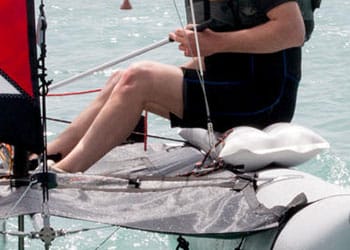
Additional Equipment
MiniCat has a comprehensive catalog of accessories for their boats. From front trampolines to motor mounts and even a gennaker, there is a way to spice up your next adventure!
MiniCat 460 Technical Specifications
| Overall Length | 15' 1" |
|---|---|
| Overall Width | 7' 3" |
| Air Draft | 21.5' |
| Water Draft | ~14" |
| Total Weight | Esprit 139 lbs / Elite 129 lbs |
| Sail Area (Jib + Main) | 124 ft² (38 ft² + 86 ft²) |
| Mast Specs | 20' (Aluminum 20 lbs / Carbon 10 lbs) |
| Crew Capacity | 1-4 people |
| Carrying Weight Capacity | 1234 lbs |
| Hull Material | Heytex 5509 PVC |
Packing & Assembly Specifications
| Bag 1 (w/ wheels) | 68" x 12" x 12" |
|---|---|
| Bag 2 (w/ wheels) | 68" x 12" x 12" |
| Bag 3 (w/o wheels) | 39" x 12" x 12" |
| Assembly Time (1 person) | ~45 minutes |
| Trailer Needed | None |
| Tools Required for Assembly | None |

MiniCat Featured Accessories
Be ready for anything with our full line of accessories.
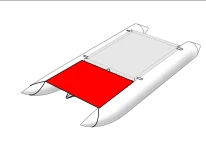
Front Trampoline for All MiniCat Sailboats
This trampoline can support up to 44 lbs of cargo and supplies, perfect for a cooler and fishing gear!
Be sure you are selecting the trampoline for your model MiniCat.
Code 0 Sail for MiniCat 460
One (1) Screecher with a furler for a MiniCat 420 or 460. This is a high quality with a cut similar to a traditional Code 0 sail. It is a little flatter than the old gennaker which allows for better reaching. This sail is on a continuous line furler which makes this sail very simple to operate and stow.
The sail area for the 460 version is 106.5 ft² (9.9 m²).
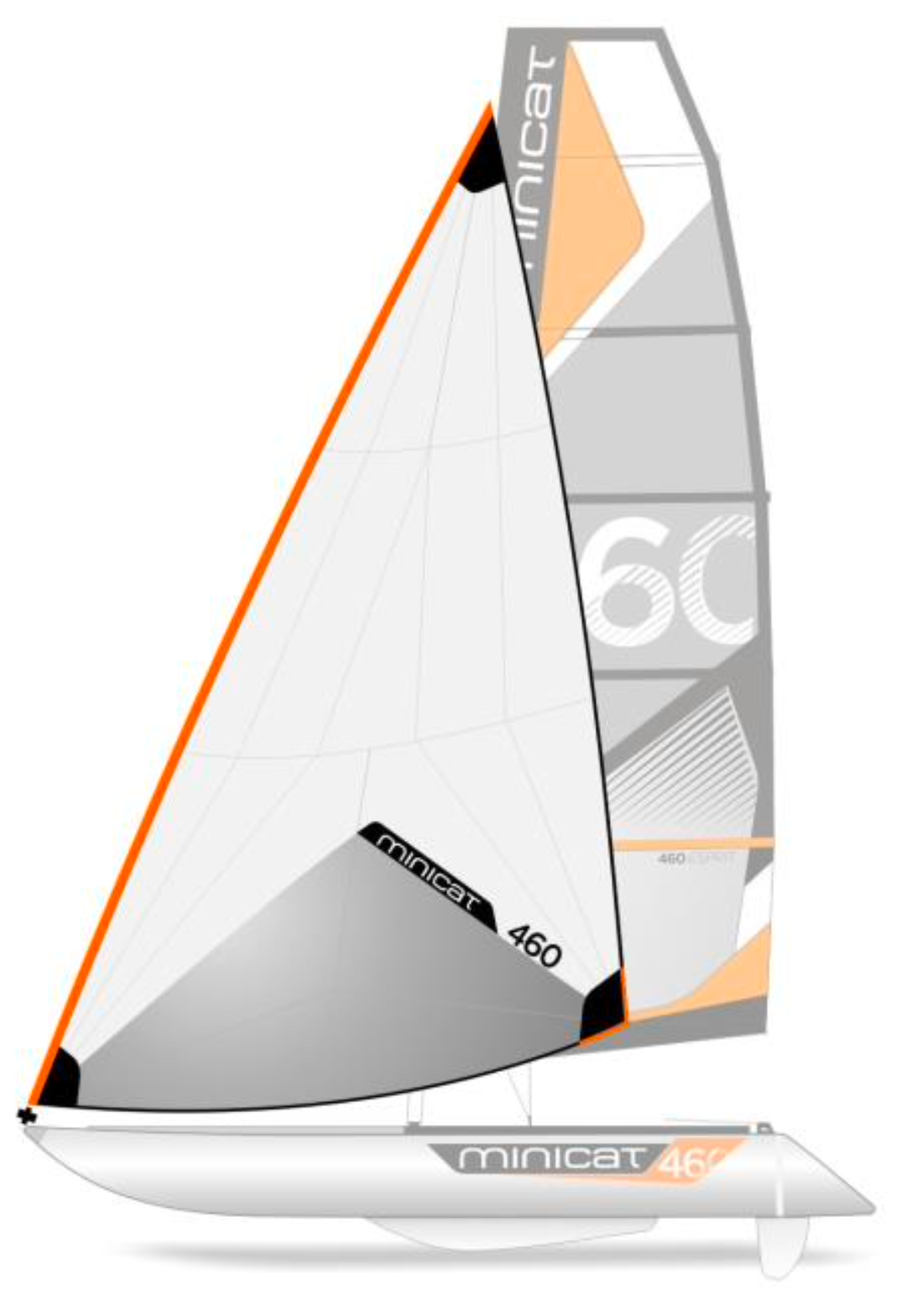
Wheel Bag Upgrade for MiniCat 420 and 460
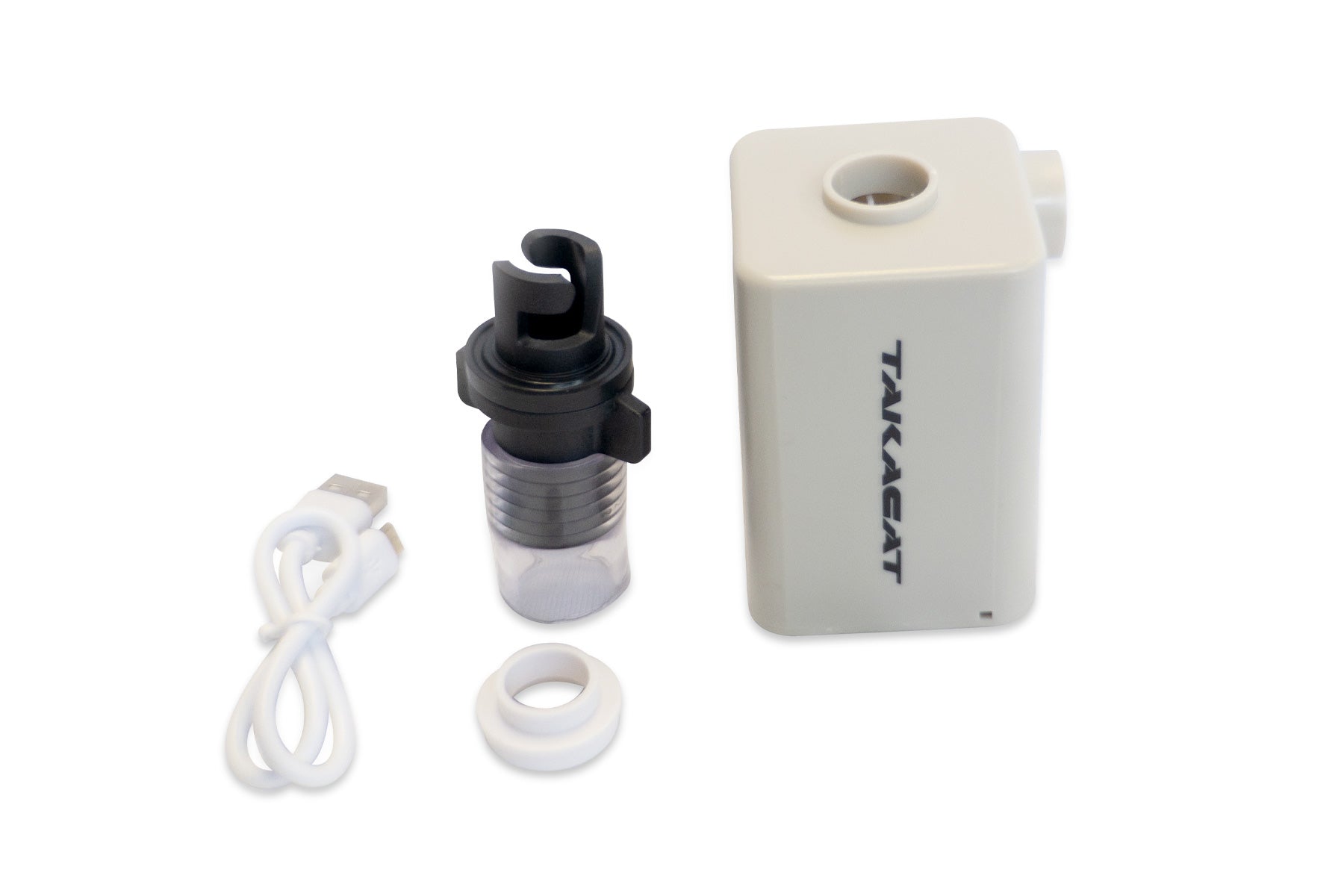
Takacat Volume Inflator
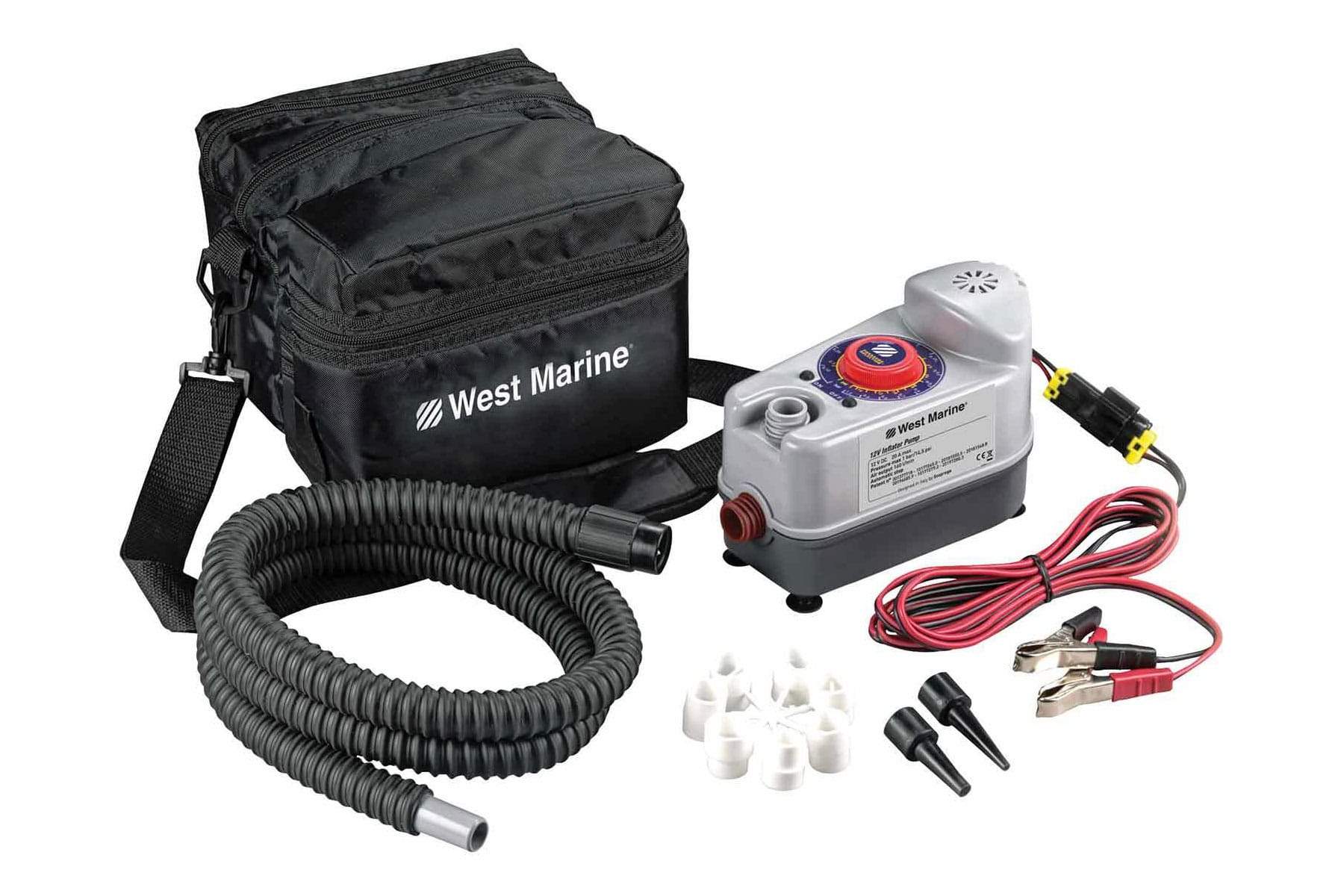
Deluxe Inflator Pump
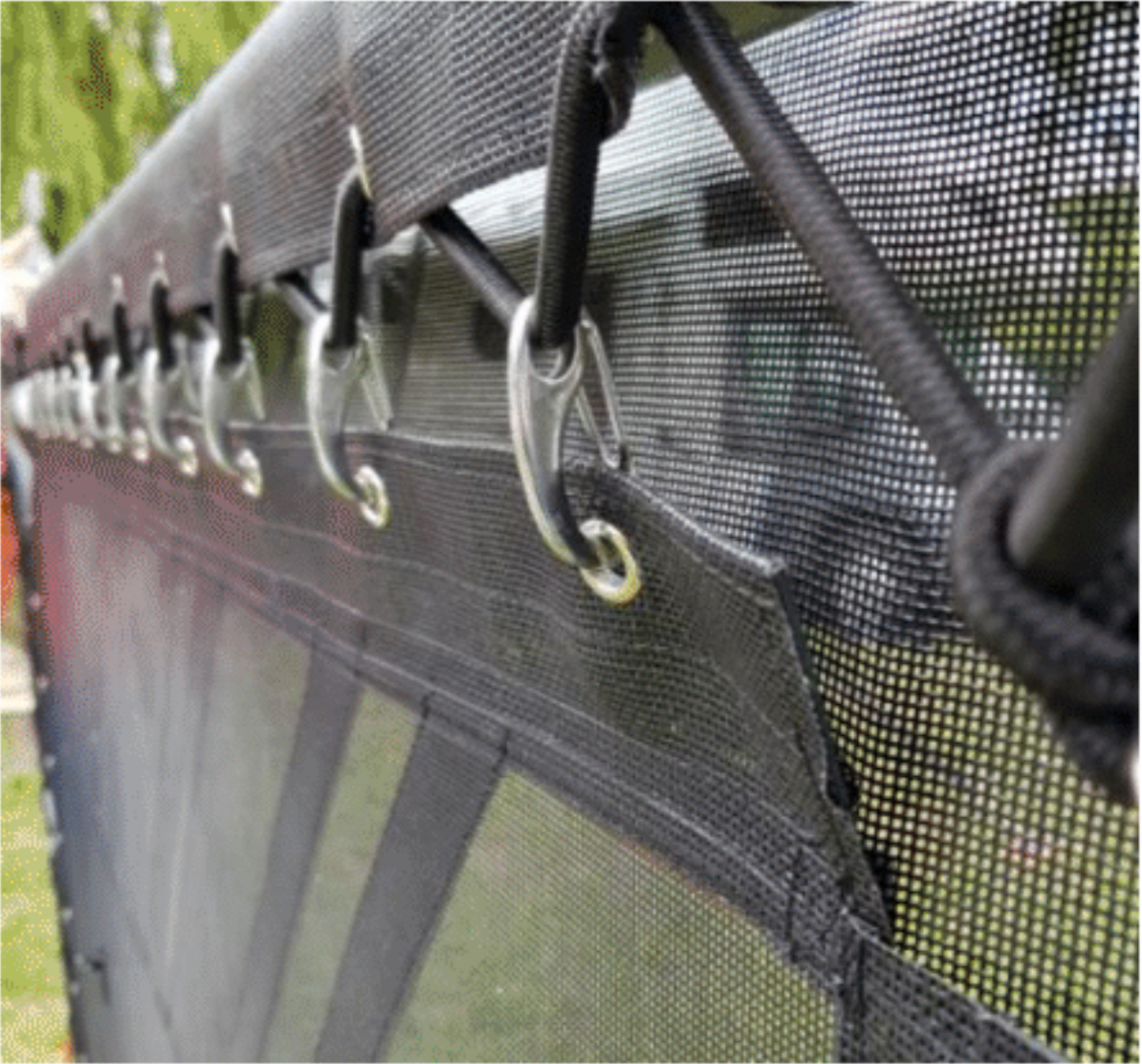
FAST Lacing Upgrade Kit for MiniCat 460

Pressure Gauge
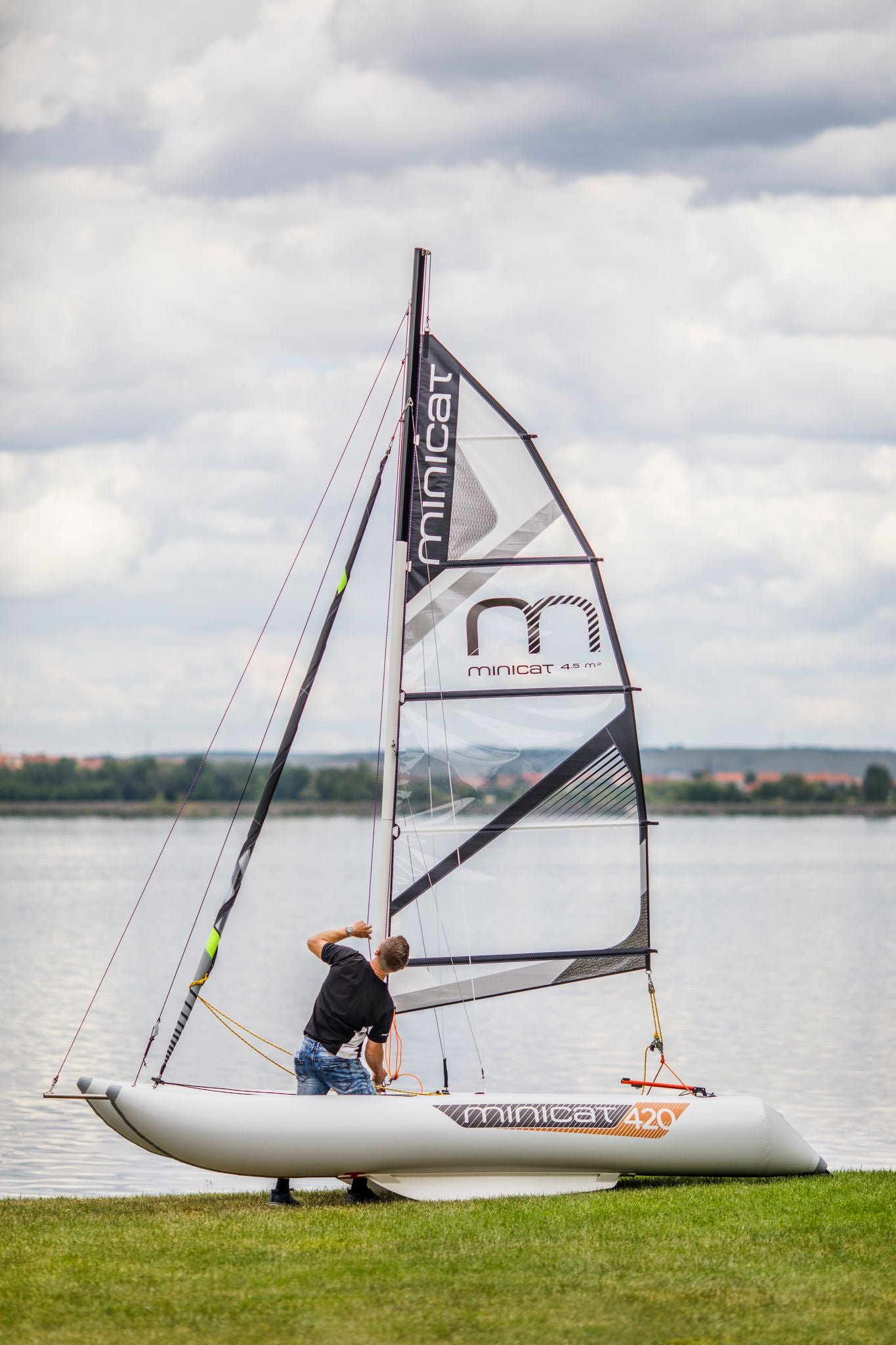
Minicat Pintop Mainsail

Inflatable Seats MiniCat 420 and 460
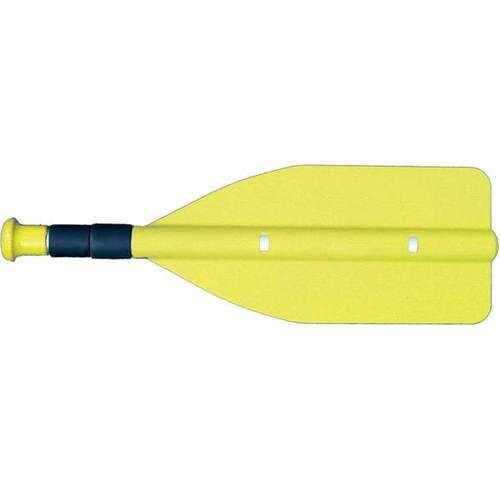
Telescopic Paddle
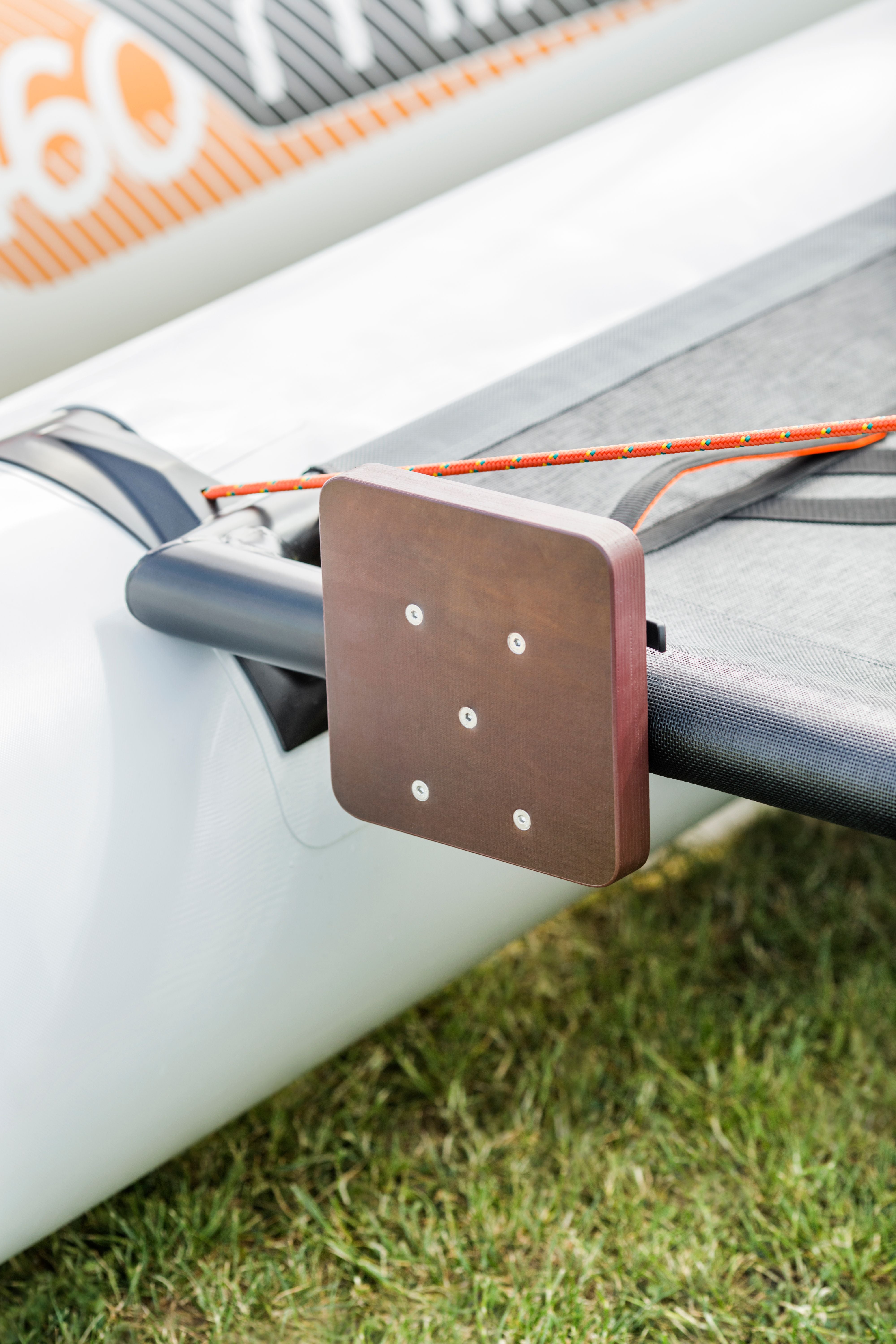
Outboard Mount For Minicat 460
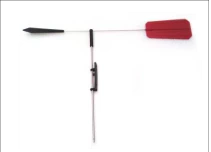
Wind Vane for MiniCat Sailboats
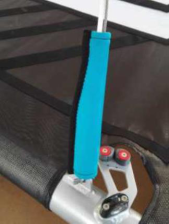
Neoprene Shroud Covers
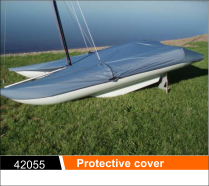
UV Protective Cover for MiniCat 460 Sailboats
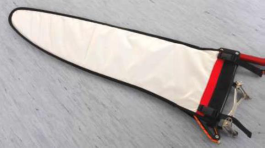
Protective Rudder Cover
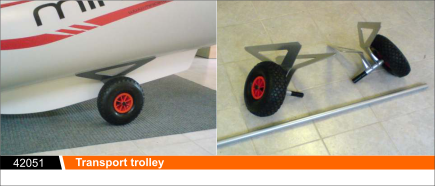
Transport Trolley Wheels for MiniCat Sailboats
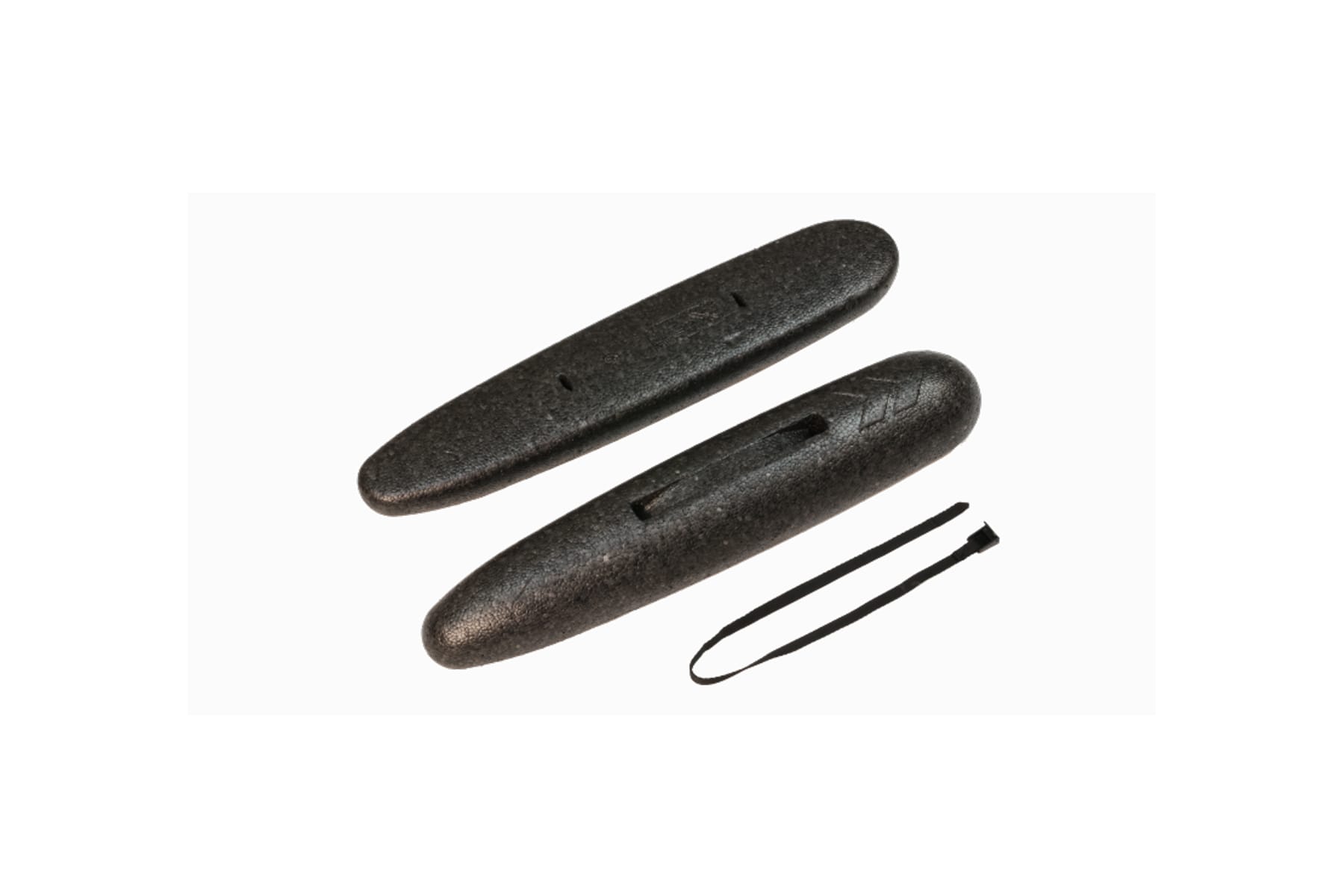
XCAT Mast Float
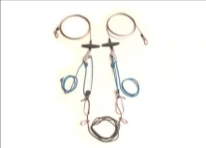
Trapeze Kit MiniCat Sailboats
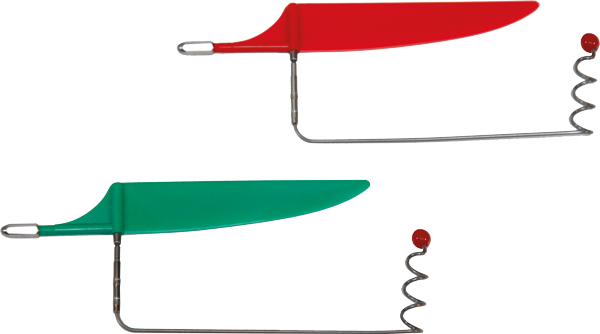
Happy Cat Shroud mounted Wind Vanes
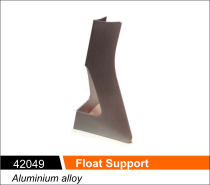
MiniCat Float Support
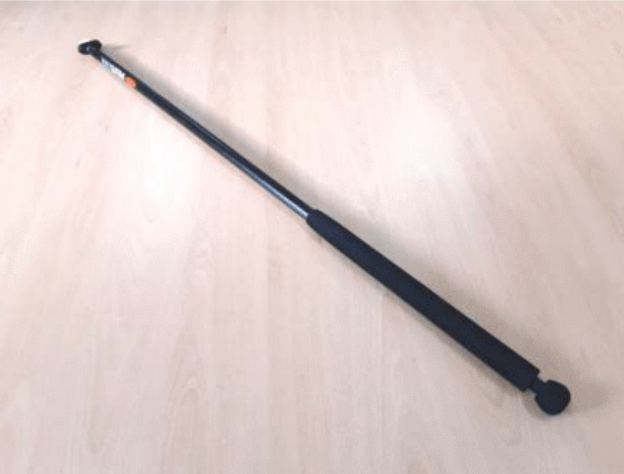
Upgrade to Telescopic Tiller Extension for MiniCat 460
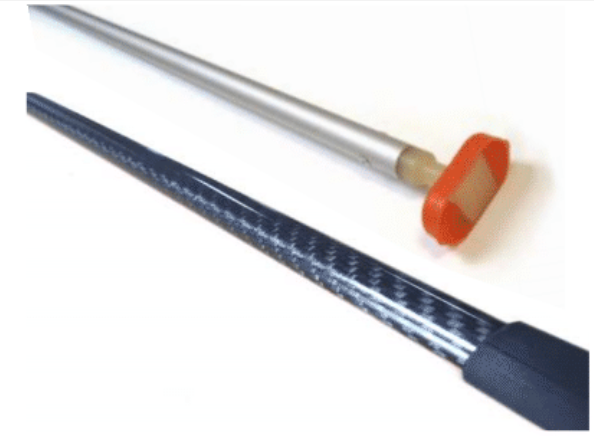
Upgrade to Carbon Tiller Extension for MiniCat 460
Spare minicat 460 hull bag.
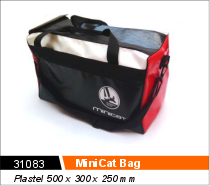
MiniCat Bag
Spare minicat 460 boat bag.
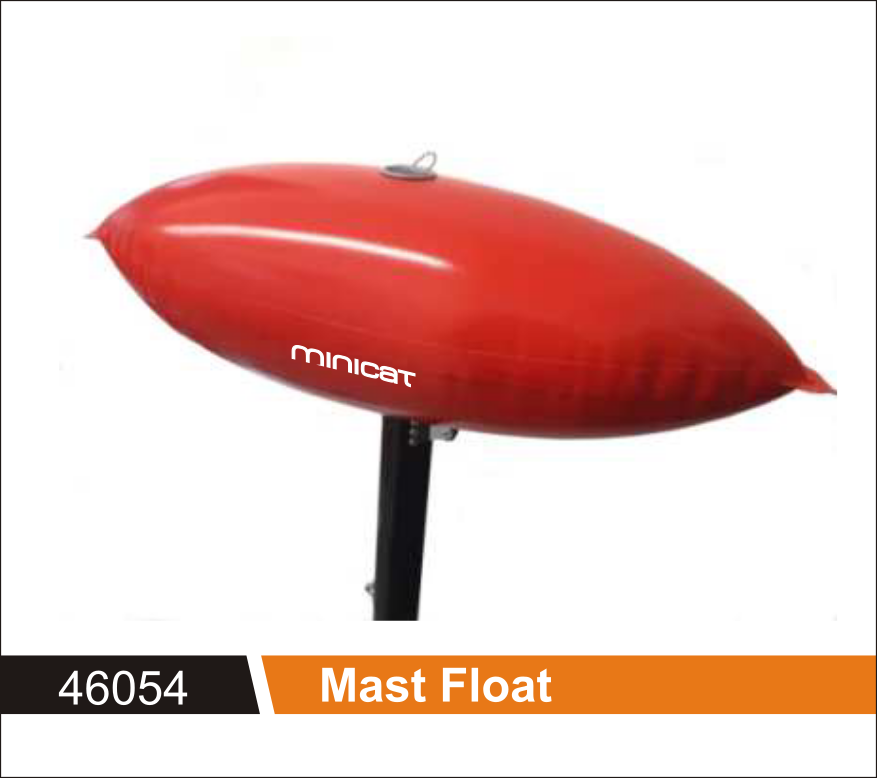
Mast Float for MiniCat 460 Esprit Sailboats
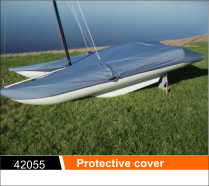
UV Protective Cover for MiniCat 420 Sailboats
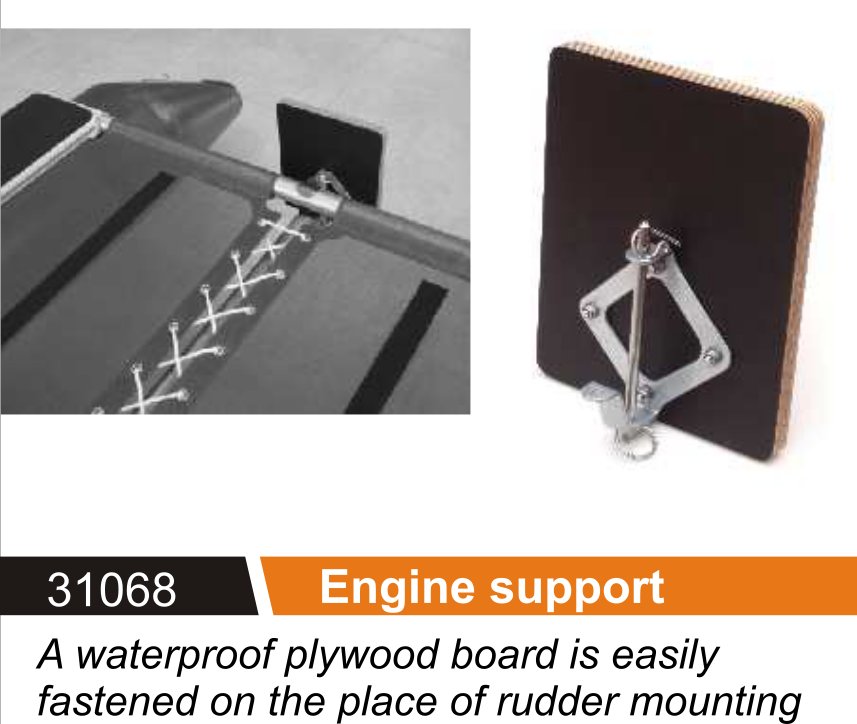
Outboard Mounts For Minicat Guppy Sailboats
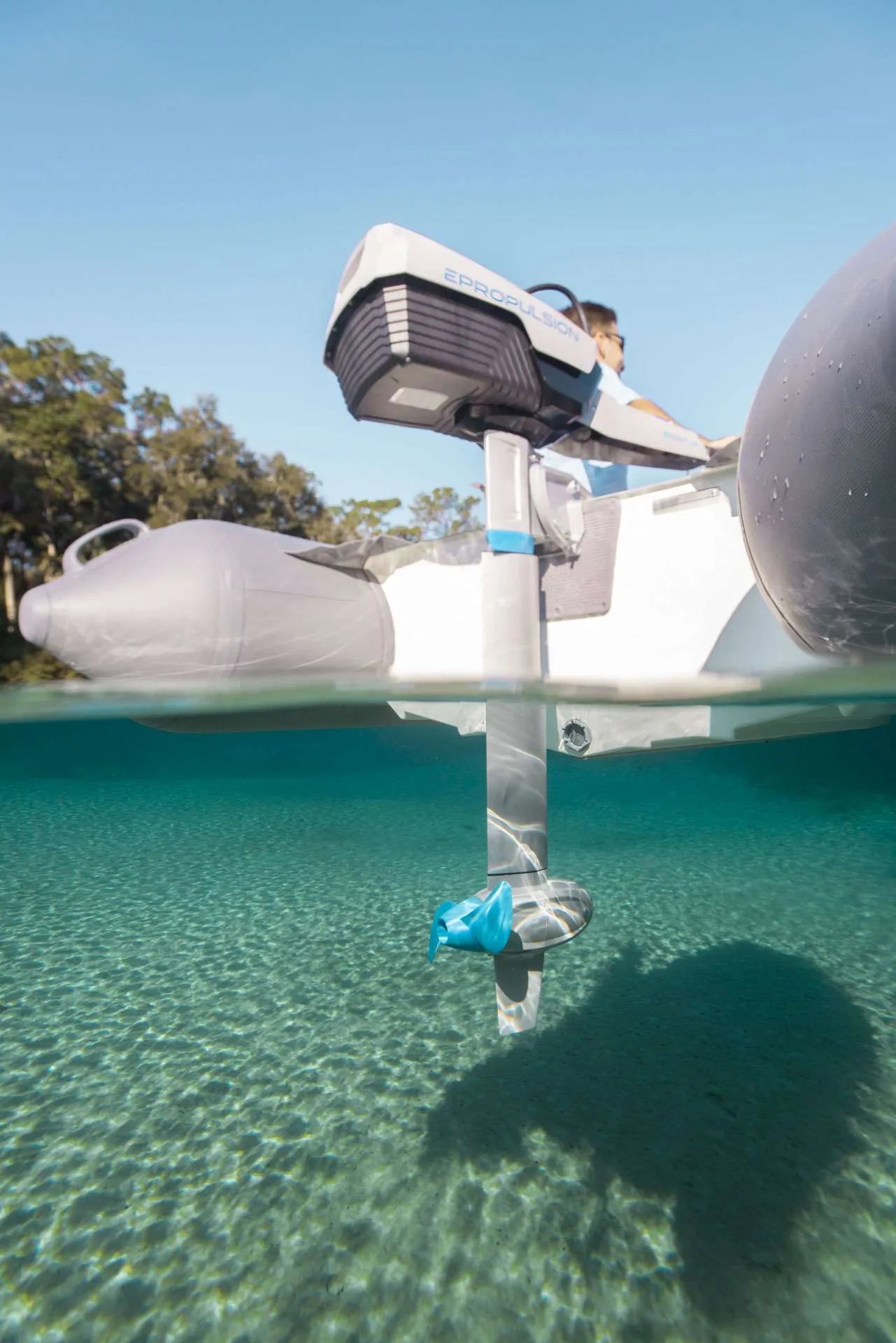
ePropulsion Spirit 1.0 Plus Long Shaft
Three reasons you need epropulsion for your boat: clean, easy, quiet..
With a seamlessly attachable lithium battery and outstanding efficiency, the Spirit 1.0 Plus is a great alternative to rowing or a noisy gas outboard. The Spirit 1.0 Plus can do everything a 3 HP outboard motor can, but is lighter, cleaner, quieter, and more convenient.
Easily push a dinghy to and from shore or us it to reliably and efficiently dock small to medium racing sailboats. When needed, the large prop provides more low RPM thrust than its equivalent gas outboard.
ePropulsion has mastered the direct drive motor. The only noise this motor makes is the sound of the boat's hull passing through the water, it is literally quieter than a whisper (no high pitched whine like other motors on the market).
Note: Because many customers choose to purchase multiple batteries, the Spirit 1.0 Plus does not include a battery pack. Be sure to add one or more to your cart below.
Package Includes:
ePropulsion Spirit 1.0 Plus Long Shaft, integrated tiller, on-board computer, GPS-based range calculation, Motor Mount, and 2x emergency magnetic stop key.
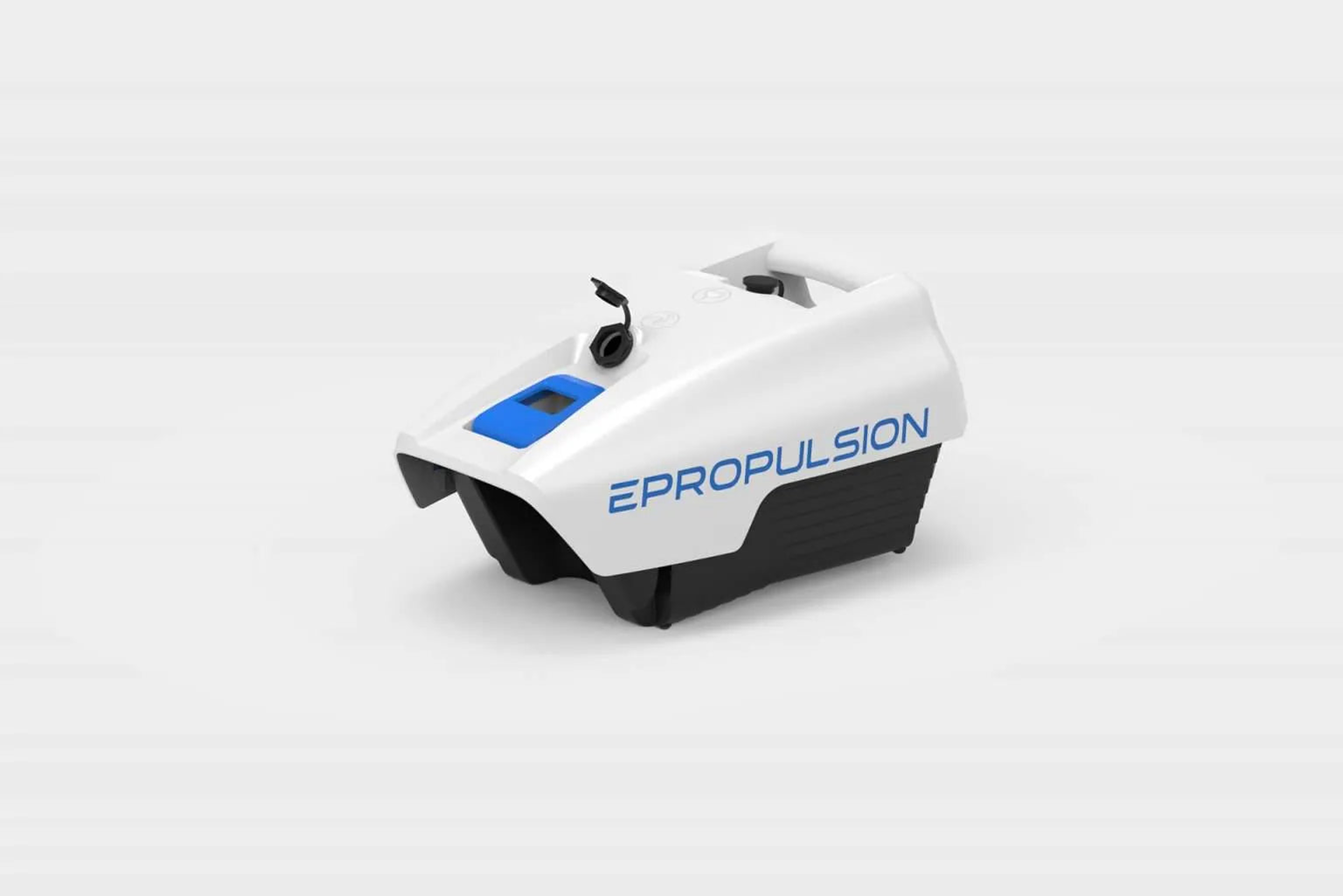
ePropulsion Spirit 1.0 Battery
Lightweight - Weighing only 19 pounds, anyone can carry and install this battery.
Efficient - On one charge you can easily do 22+ miles at almost 5 mph!
Maintenance Free - Sealed, watertight construction ensures never need to do anything but charge the battery for the life of your motor!
Floats - If you accidentally drop this pricey e-tank, no worries, it floats!
Powerful - Holds 1275Wh of battery capacity.
Buy more than one battery to extend your cruising range.
Resources & Support
MiniCat Sailboat Warranty MiniCat offers a 24-month warranty on the entire sailboat and a 7-year warranty on the hull skin material. These warranties cover material and workmanship defects that affect the performance of the boat. To register your boat, click here. To file a claim or for assistance with your MiniCat, please email us at [email protected] or give us a call at 410-705-5026.
MiniCat Full Line Sales Brochure MiniCat 460 Esprit Owner's Manual MiniCat 460 Elite Owner's Manual
Sign Up for Our Newsletter
Receive exclusive offers, and be the first to know about upcoming events, demos, sales, and discounts.
- Storage Solution
- Transport Solution
- Minicat for Campers
- Minicat for Yachts
- Minicat Factory
- Minicat Events
- Laura Dekker
- Laura Dekker’s Foundation
- Testimonials
- Minicat Guppy
- Minicat 310
- Minicat 420
- Minicat 460
- Minicat as a tender
- Parts & accessories
- Used boats for sale
- Distributor map
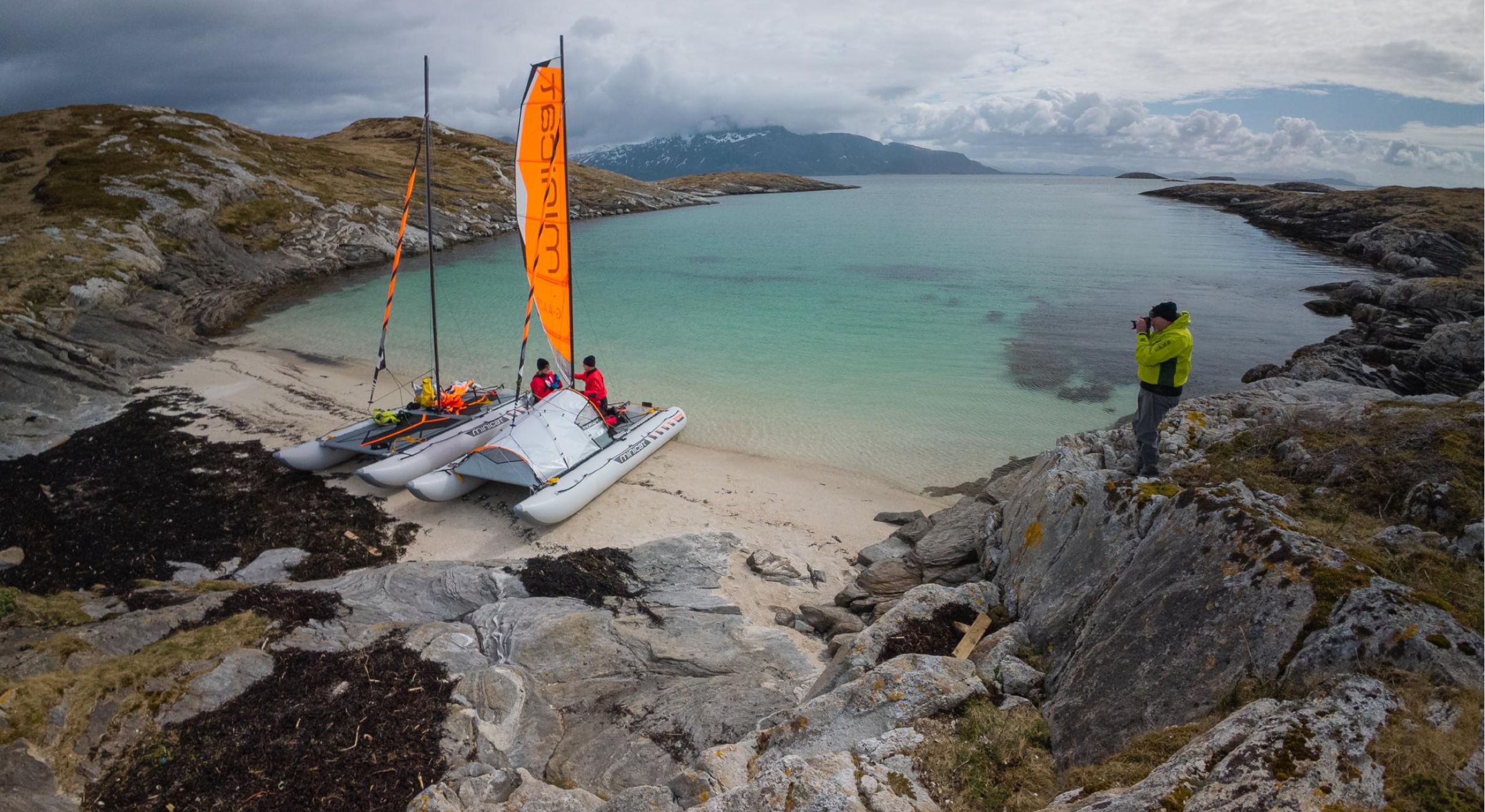
MiniCat 520 EXPLORER IS COMING …
For almost two years we have been working on an all-new new expedition/touring style of MiniCat and we are beyond excited to have finally got the first boats in the water for extreme endurance testing in the harsh conditions they were designed for.
The MiniCat Expedition Team is headed up to the north of Norway to spend a week sailing inside the Arctic Circle to fully test these first boats before we start full production and in advance of an epic Arctic expedition planned for August..
The team is led by Dave King a renowned and extremely experienced arctic explorer and expedition leader, and amongst the team of experienced extreme sailors, he was also joined by ‘Mr. MiniCat’ himself, Martin Horak. A unique opportunity for Martin to experience firsthand the boats he’s been designing and building.
Base Camp is was established, and Dave & Martin had their first sail under the midnight sun on the first night. Their first impressions were very positive and even beyond expectations. The weather is bright but cold, however the following days delivered a lot of rain, horizontal rain, and strong wind.
The following days saw the MiniCat Explorers really tested to their limits, and almost beyond! Hours and hours of hard sailing in truly extreme conditions with the boats in different configurations and handling different loads, the testing program was intense.
As seen in these images the new MiniCat Explorer comes with the unique ‘MiniCat Pod’ fitted, this specifically designed, water-proof protection pod enables a sailor to stay protected from the elements whilst checking navigation or taking a rest. The Pod also offers a safe protected place for storing valuable equipment and personal gear and can be easily removed and used as a tent onshore overnight.
We have an epic Arctic Expedition planned in August to the north of Greenland which will be the ultimate test. We will then be ready to start production of this very exciting new MiniCat model later this year. We will be publishing the full details of the production version of the ‘MiniCat 520 Explorer’ shortly.
Here is what our new MiniCat ambassador Dave King said about MiniCat 520 Explorer:
“After testing the new and coming 520 Explorer I just wanted a word and a nod to Martin & MiniCat, without getting to sound like the salespersons, these things (MiniCats) are epic, the opportunities limited only by the imagination and they really function as we`ve all imagined. I covered over 60km with ease, in variable conditions yesterday with about 200kg loaded plus me. For expeditions or just plain family outings, these boats have to generate some real buzz ! So happy with how this boat is turning out!”
With Love – Team MiniCat

Click below to start
WhatsApp Chat is free
the first electric catamaran
BUILT IN THE UAE
The Innovative, fully electric SeaQuest Catamaran
Performance sailing and offshore cruising ability combined like never before so you can sail faster and voyage further..
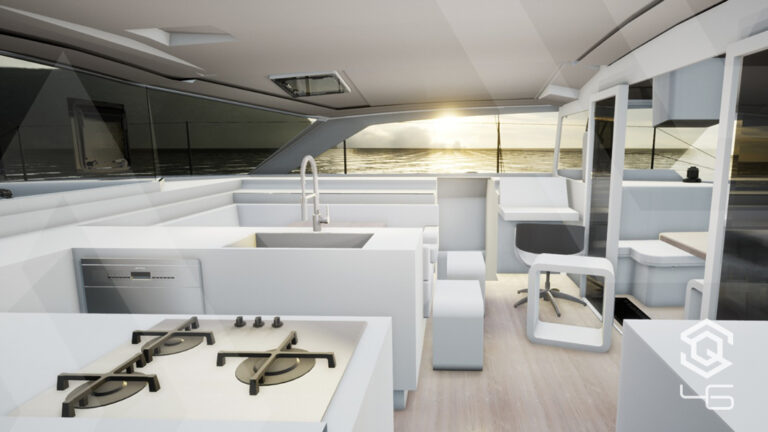
A NEW LEVEL OF COMBINED PERFORMANCE, STYLE, AND CAPABILITY
The synergy between elite design, build excellence, and progressive technology achieves a completely new level of combined performance, style, and capability. Advanced hull design, semi carbon-fibre construction, and acute attention to weight throughout, deliver performance without compromising an ounce of comfort.
LET NATURE FLOURISH
Switching to electric propulsion makes a huge impact on the oceans
light, fast and strong
Utilizing new hybrid resins and high-density foam core, this sandwich construction is vacuum infused, maximizing resin to fibre ratios. A combination of carbon and E-Glass construction culminates in an exceptionally light, fast, and sturdy catamaran.

BEHIND THE SCENES

Catamaran Quest
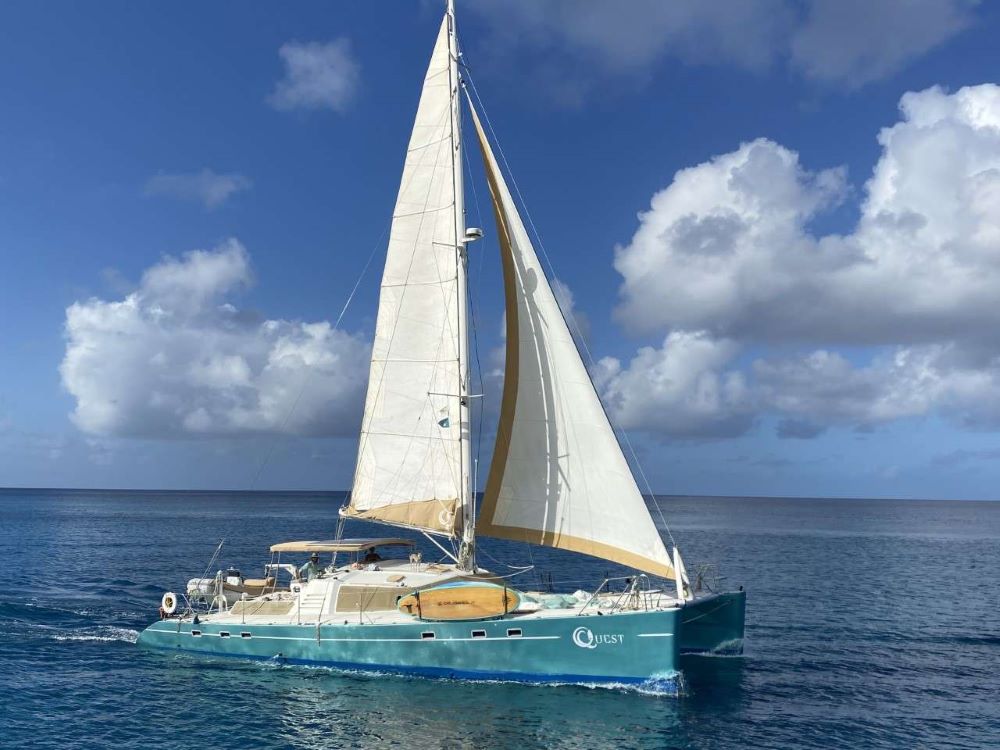
| Guests | Up to 6 | |
| Guest Cabins | 3 | |
| Length | 57ft | |
| Guest Cabin Configuration | 3 Queens en-suite w/AC | |
| Designer | Alex Simonis | |
| Launched | 1991 | |
| Home Port | Yacht Haven Grande, St Thomas, US Virgin Islands | |
| Scuba | Rendezvous only | |
Catamaran Quest Overview
Quest is a 57′ Simonis classic catamaran. She’s a smooth sailing yacht, a spacious live aboard, and an adventure waiting to happen. She’s both the journey & the destination.
Quest features four double en-suite guest cabins. A/C is available throughout for guest’s comfort. After many years of offering charters for up to 8 passengers, Quest is now a 6 guest yacht. This creates a more comfortable, attentive and specialized experience for all aboard. It also allows the crew to occupy a full stateroom while leaving extra crew quarters for add-ons like a private masseuse or dive instructor.
The yacht has both indoor and outdoor dining seating, large nets in the forward bow for lounging about and enjoying the sea spray. The stern provides a fully equipped dive deck / swim platform, also great space for yoga or sunbathing.
- Overview
Advertisement

COMMENTS
Fleetwood - The Mini Quest by Lachlan Davidson, 2010 In about 1979 my wonderful mother agreed to buy my sister and I a Mini Quest catamaran. They are fourteen feet long, designed (by Charlie and Lyndsay Cunningham) to be built at home and to be raced by a single person.
The Snowgoose (all iterations) was the first truly popular mass produced catamaran with more than 500 built. Known as safe, strong and capable of being sailed off shore, which some say is because of the position of their main mast, they make a perfect coastal cruiser or circumnavigator for an adventurous couple. This is a lot of boat for the money. These boats began their model run as a 35 ...
Looking for the perfect mini catamaran? Read why the MiniCat 310 is an excellent sailboat for for new sailers to seasoned veterans. Read the full review here.
The MiniCat 420 is the most versatile model in the lineup, accommodating up to 4 adults and with most models supporting the optional gennaker, trapeze, and motor mount. On the Emotion and premium models, upwind performance is the best, with a boom complete with outhaul and vang to provide better con
Looking for a simple, affordable, and comfortable cruising boat? An overview and comparison of 10 of the most popular small catamarans.
Meet the MiniCat 420. The most popular inflatable catamaran sailboat on the market. Ultra-portable & built with performance in mind. Shop online at Red Beard Sailing.
The redesigned MiniCat 310 is based on the original MiniCat that Laura Dekker discovered on her circumnavigation. It provides great low wind performance with both jib and main sails, yet still packs into a single bag. It remains one of the most popular models in the lineup.
Understanding a Catamaran The first step in learning how to sail a small catamaran is to understand its essentials. We begin by looking at what a catamaran is, its essential features, and some standard sailing terms. Understanding the necessary parts of a cat and sailing terminologies helps with communication when sailing. What Is a Catamaran?
The Smart Cat S280 is the smallest sailing catamaran with a liveaboard design and layout. Inside, you'll find ample space featuring three queen-size berths, a head/shower, a kitchen, and an office space. Enjoy comfortable living aboard with perfect privacy, making every voyage a home away from home.
MiniCat - or rather its founder, the Czech Martin Horak - became interested in the idea of an inflatable catamaran 14 years ago. His goal was to offer a real sailing boat, easy to assemble and transportable in simple bags.
CraigCat E2 Elite Since 1990 the patented CraigCat horizontal Catamaran is unique in form and function. Super high quality and made of only the finest materials available, and built in Orlando Florida. This state of art craft not only appeals to all ages, men and women alike, but defies the world of regular boats and personal watercraft. CraigCats are super stable, comfortable side-by-side ...
The MiniCat 460 is the sportiest boat in the fleet for MiniCat measuring 15 feet overall length. An Ultra-portable, inflatable mini catamaran. Shop now
We will be publishing the full details of the production version of the 'MiniCat 520 Explorer' shortly. Here is what our new MiniCat ambassador Dave King said about MiniCat 520 Explorer: "After testing the new and coming 520 Explorer I just wanted a word and a nod to Martin & MiniCat, without getting to sound like the salespersons, these ...
The synergy between elite design, build excellence, and progressive technology achieves a completely new level of combined performance, style, and capability. Advanced hull design, semi carbon-fibre construction, and acute attention to weight throughout, deliver performance without compromising an ounce of comfort.
Charter 57ft Alex Simonis Catamaran Quest, sailing the Virgin Islands with a professional crew. All-inclusive Crewed Catamaran Charter Vacations.
MiniCat test sailing - true dedication! When you arrange a test sailing you're always hopeful for good weather, sometimes the sun doesn't shine,...
The 2021 Moscow Boat Show started today. The team from MiniCat Russia are there with the latest MiniCat models available. You can even try a MiniCat 420...
117 Catamaran St. Marina del Rey, CA 90292 +1 (805) 290-2842. Also at this address. Filmmakers International Association. Restaurant Supply Drop. 1 reviews. Find related places. Bars. Hotels. Own this business? Claim it. See a problem? Let us know. You might also like. Motels. The Rock Brentwood. 1
MiniCat Russia have been gearing up for the season at the Moscow Boat Show, we're looking forward to the team and their enthusiastic customers joining us...
What a great shot - looks like loads of fun in Moscow #minicat